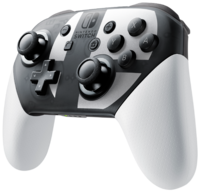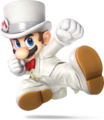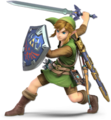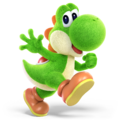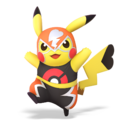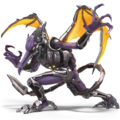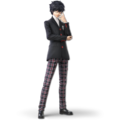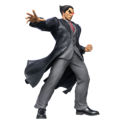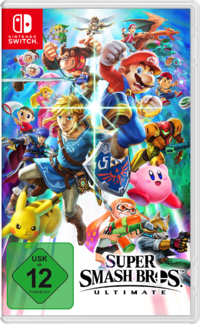Super Smash Bros. Ultimate
- "SSBU" redirects here. For this game's Wii U predecessor, see Super Smash Bros. for Wii U.
| Super Smash Bros. Ultimate | |||||||||||||||||||||||||||
|---|---|---|---|---|---|---|---|---|---|---|---|---|---|---|---|---|---|---|---|---|---|---|---|---|---|---|---|
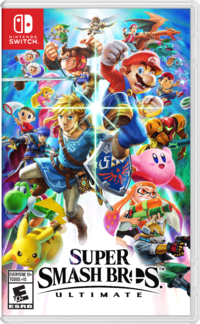 For alternate box art, see the related gallery. | |||||||||||||||||||||||||||
| Developers | Nintendo Sora Ltd. BANDAI NAMCO Studios Inc. | ||||||||||||||||||||||||||
| Publisher | Nintendo | ||||||||||||||||||||||||||
| Platform | Nintendo Switch | ||||||||||||||||||||||||||
| Release dates | |||||||||||||||||||||||||||
| Languages | English (United States) English (United Kingdom) Japanese Chinese (Simplified) Chinese (Traditional) Dutch French (Canada) French (France) German Italian Korean Russian Spanish (Latin America) Spanish (Spain) | ||||||||||||||||||||||||||
| Genres | Fighting/Action | ||||||||||||||||||||||||||
| Ratings |
| ||||||||||||||||||||||||||
| Mode | 1–8 players | ||||||||||||||||||||||||||
| Format | Nintendo Switch: | ||||||||||||||||||||||||||
| Input | Nintendo Switch: | ||||||||||||||||||||||||||
| Serial codes | |||||||||||||||||||||||||||
Super Smash Bros. Ultimate is the fifth game in the Super Smash Bros. series, released for the Nintendo Switch. The game was announced through a teaser trailer in the March 2018 Nintendo Direct[2] and was released worldwide on December 7, 2018. The game features 103 base stages and 74 base playable characters (with more fighters and stages as downloadable content), the largest respective numbers in the series.
Super Smash Bros. Ultimate was made available for pre-order and pre-loading from the Nintendo eShop beginning November 1, 2018. The game takes up approximately 14.3 GB of the Nintendo Switch's storage when downloaded from the Nintendo eShop.
Super Smash Bros. Ultimate is the sixth (fifth if Super Smash Bros. for Nintendo 3DS and Super Smash Bros. for Wii U are counted as one game) game related to the Super Mario franchise to receive a PEGI 12+ rating in Europe, being preceded by the previous three Super Smash Bros. installments (Super Smash Bros. Brawl, Super Smash Bros. for Nintendo 3DS, and Super Smash Bros. for Wii U) and the Wii U Virtual Console releases of Super Mario 64 DS and New Super Mario Bros.
Gameplay[edit]
Super Smash Bros. Ultimate retains the series' basic gameplay elements, with several new mechanics and changes. As with previous installments, the objective of the game is to launch opponents off the stage. Players build each other's damage percentage through attacks, and the higher the percentage, the farther they fly when they are hit. This time, the damage display is in decimal notation, adding a tenth to the number. Decimals have always been used for damage calculations since Super Smash Bros. Melee, but the damage percentages were always displayed as an integer on-screen. Super Smash Bros. Ultimate is the first time that decimal notations are shown in-game. Additionally, when an opponent is launched, their launch speed is the fastest at the start, unlike in previous games in the series. During 1-on-1 battles, all fighters' attacks deal 1.2x their regular damage, which is done to "increase gameplay speed."[3] Additionally, characters can use any ground attack out of a run (e.g. neutral attacks, tilt attacks, smash attacks), while any aerial attack can be used while climbing a ladder, officially known as a "ladder attack".
Three techniques are also introduced in Super Smash Bros. Ultimate: the Directional air dodge, Short-Hop Attack, and a new version of the Perfect shield. The Directional Air Dodge, a technique carried over from Super Smash Bros. Melee, allows the player to dodge while moving in the direction they tilt , which can also be used for recovery. However, if a player dodges excessively—whether in the air or on the ground—they become more vulnerable to attacks, with less intangibility and lower dodge speed. The Short-Hop Attack is performed by pressing the attack and jump buttons at the same time, allowing the player to hop a short distance off the ground while performing an air attack; however, all short-hopped aerial attacks deal 0.85x their regular damage (excluding special moves, and certain states such as Peach and Daisy's Floating Jump attacks and the Super Leaf item). The Perfect Shield can be used to block attacks without depleting the user's shield. However, unlike in past installments, where it is activated by pressing the shield button before an attack connects, the Perfect Shield is instead performed by releasing the shield button just as an opponent's attack lands, nullifying the attack.
During a match, the fighter that is in the lead occasionally emits a glimmer of light. If a match enters Sudden Death, unlike in previous games where Bob-ombs begin to drop after some time, the screen slowly zooms in on the center of the stage, shrinking the field of view and stage boundary and thereby making it easier for fighters to be KO'd. The Sudden Death mode is visually accompanied by flames that intensify as the screen zooms in on the stage. Bob-ombs still drop on the stage if enough time passes and no one is KO'd.
As with Super Smash Bros. for Wii U, Super Smash Bros. Ultimate also supports Nintendo GameCube Controllers.
Super Smash Bros. Ultimate is available in 11 different languages: Japanese, English, French, Spanish, German, Italian, Dutch, Russian, Simplified Chinese, Traditional Chinese, and Korean, all of which are fully voiced. However, the Chinese versions use the Japanese voice set, and some of the specific names (characters, stages, items, etc.) are also not translated and use their English names instead, probably due to copyright reasons (mostly for third-party games), or they were not intended to have official Chinese versions for the original games. Though, all of the DLC contents so far are fully localized in the Chinese versions. This is the second Super Smash Bros. game to have a Simplified Chinese localization (the first being the iQue Player release of Super Smash Bros.), and the first game to have a Traditional Chinese localization. The player can also change the dialect for the English, French, and Spanish languages by changing the "Region" setting in the System Settings for the console (though in the case of English, it only changes the names for certain characters, stages, etc., such as Duck Hunt being called "Duck Hunt Duo" and the Find Mii stage into "StreetPass™ Quest", as well as release dates in tips). Super Smash Bros. Ultimate is the first installment in the series to feature Dutch and Russian announcers.
Smash[edit]
- “Battle up to eight fighters.”
- —In-game description
Before starting a match, the player can create their own preset rules, such as the number of stocks and time limit, which they can quickly select at any time. In addition to Time and Stock modes, Stamina mode is now a standard mode alongside the aforementioned two and is no longer a part of Special Smash. Stocks can also be added to Stamina mode - and it can now be played online.[4]
8-Player Smash also returns from Super Smash Bros. for Wii U, and can now be played on any stage from the start.
A new rule option added to Super Smash Bros. Ultimate is the Final Smash Meter, which appears below each fighter's damage meter and fills up as the player takes damage from opponent attacks, similar to Little Mac's Power Meter. Once it is full, the player can then use a Final Smash. These Final Smashes deal less damage and knockback than regular Final Smashes obtained from Smash Balls, and like them, only one can be used at a time.
Squad Strike[edit]
- SmashWiki article: Squad Strike
Squad Strike (Japanese: 団体戦 Dantaisen, Team Competition) is an elimination-style battle mode added to Super Smash Bros. Ultimate. The player can choose between 3-on-3 or 5-on-5 Squad Strikes, which can be carried out with one player on each side playing as three or five characters, or three or five players on each side each playing as one character. In a Squad Strike, both sides battle each other as the three or five characters consecutively in one battle. Characters can only be picked once per team, including amiibo fighters.
Tourney[edit]
- SmashWiki article: Tourney (SSBU)
Tourney returns from Super Smash Bros. Brawl, allowing up to 32 participants to compete. After selecting the number of total participants, the number of CPU players and tourney type, the game automatically generates a tournament bracket. This bracket can be shuffled, but not edited manually. This mode is also compatible with amiibo fighters.
Special Smash[edit]
- SmashWiki article: Special Smash
Special Smash from previous installments returns, this time with three sub-modes. The first is Custom Smash, which works the same way as in Special Smash from Super Smash Bros. Brawl and Super Smash Bros. for Wii U, except there is no longer a Stamina option due to it being a part of the basic rule selection. The 300% setting has been split into Super Sudden Death, which works similarly to the rule of the same name in Super Smash Bros. Melee.
Smashdown[edit]
- SmashWiki article: Smashdown
In the new, third mode, Smashdown (Japanese: 全員バトル Zen'in Batoru, All-Members Battle), players enter a series of matches selecting a character for each one. After one match ends, however, the characters used in that match are no longer available for subsequent matches, forcing players to select a different character for the next one. Smashdown is the only mode that supports 8-Player Smash.
Spirits[edit]
Adventure[edit]
- SmashWiki article: Adventure Mode: World of Light
The Adventure mode in this game is called World of Light. It has a board game-like map, and elements and maps based on various games have been shown; Warp Pipes and ! Switches are noticeable. Unlike The Subspace Emissary, which is very plot-heavy, World of Light is used to demonstrate the functionalities of spirits and spirit battles and has a very loose plot to leave the player free to explore the light and dark realms of the Adventure mode. World of Light also has considerably fewer cutscenes than The Subspace Emissary, though most of them are silent, akin to The Subspace Emissary's cutscenes; the lone exception being the introductory scene.
During the events of the Adventure mode, a monster called Galeem defeats all of the fighters except Kirby, imprisoning them in the eponymous World of Light, where they are cloned and their clones are possessed by spirits, which are the other victims of Galeem's attack. Once Kirby has freed Mario and more fighters and spirits in the Light Realm and defeated Galeem, a new monster named Dharkon appears, opening a path to the Dark Realm, forcing Galeem to retreat. When the remaining fighters and spirits are freed in the Dark Realm (as well as defeating Dharkon), Galeem appears to confront Dharkon, putting the player in a third realm: a mixture of the Light and Dark Realms.
Within the mode, only Kirby is available from start; the rest of the fighters are unlocked through the mode's progress in matches similar to those of Challenger's Approach (the exception being Bowser, who becomes playable after defeating Giga Bowser). Downloadable characters can be made available to play as in World of Light by freeing 10 fighters in the mode. If the character in question is downloaded with the criteria having been met beforehand, then the character is immediately unlocked.
Three endings exist in Adventure Mode: two bad endings with Galeem or Dharkon respectively, and a true ending with both bosses. The first ending is achieved by defeating too many dark puppet fighters, thus forcing the player to fight Galeem; when Galeem is defeated, Dharkon destroys Galeem and his army, encroaching the universe in darkness. The second ending is achieved by defeating too many light puppet fighters, thus forcing the player to fight Dharkon; when Dharkon is defeated, Galeem unleashes another wave of light, essentially engulfing the universe in light again. The third ending is achieved by defeating an equal number of light and dark puppet fighters, making the player fight both Galeem and Dharkon simultaneously; when the player wins, the universe is restored to its original state, while all spirits fly back to their original worlds.
Spirit Board[edit]
- SmashWiki article: Spirit Board
The primary way spirits can be obtained is through the Spirit Board. On the Spirit Board, up to ten random spirits will appear on the board and the player can choose any one to battle against and gain the spirit. When the player wins against that spirit, it will disappear from the Spirit Board, and a timer will appear on that slot. When the timer runs out, a new spirit takes that slot. The spirits themselves also have a time limit for how long they will appear on the Spirit Board. When their time limits run out, new spirits will replace them immediately. Sometimes, there will be events happening on the Spirit Board and certain spirits will appear related to a theme. Defeating spirits during those events rewards more gold and SP than usual.
DLC Spirits[edit]
- SmashWiki article: DLC Spirits (mode)
Added in the version 3.0.0 update, a special DLC Spirit Board will appear if the player has purchased any of the Challenger Packs. Unlike the regular Spirit Board, the background and music relate to the series the DLC spirits are from, the player does not need to shoot the Puppet Fighter to obtain the spirit, and they do not disappear from the Spirit Board when they are collected, allowing them to be collected indefinitely. When the player collects all of the spirits from a DLC Spirit Board, they will be rewarded with 10,000 gold.
Collection[edit]
This sub-menu is where the player can view and modify their spirits.
- Team Setup: Players can make teams of primary and support spirits that they can quickly select when choosing spirits. It is also required to make spirit teams to use them in regular Smash matches.
- Level Up: As the name suggests, the player can use snacks or cores to level up their primary spirits, making them stronger. When certain spirits reach level 99, they can be enhanced into more powerful spirits that grant additional abilities.
- Dismiss: The player can send spirits back to the real world. They leave behind cores when they do so that pertain to their type (Attack, Shield, Grab, Neutral, or support) that can be used to level up other spirits or summon new spirits.
- Summon: The player can combine the cores from spirits into new spirits. Each spirit requires a specific combination of spirits that relate to the character to create them. In addition, the player also needs to pay a fee of SP to fuse them. Many spirits can only be obtained via Summon.
- Inventory: There are two things the player can do in the Inventory. In the Spirit List, they can look at a large list of every spirit they have obtained, while the Items menu allows the player to sell any Spirit Board items and cores that they have and get SP in return.
- Activities: There are many activities for spirits to do, but the corresponding master spirit must first be unlocked in World of Light. When the player gives away spirits to these facilities, they cannot be used, and the player will wait a period before they are done with their activity. However, they can be pulled out at any time. There are three types of activities: Gym, run by Doc Louis, allows players to place spirits there and they will level up on their own. Dojos allows spirits to gain specific strengths in their stats, but also weaknesses as well. Explore allows spirits to go out and find various items.
- Shopping: If the player saves a particular spirit in World of Light, they will unlock shops that house certain spirits and items.
Games & More[edit]
- SmashWiki article: Games & More
Unlike other Super Smash Bros. games, there is no longer a Stadium menu. Mob Smash, along with Home-Run Contest (as of version 5.0.0) are now sub-modes within the Games & More menu.
Classic Mode[edit]
- SmashWiki article: Classic Mode (SSBU)
Classic Mode returns from previous installments, returning to its original format last seen in Super Smash Bros. Brawl, in which the player fights multiple opponents in a linear series of matches to reach the end, while also trying to get a high score. This time, each fighter has a set series of opponents to face. Unlike Classic Mode's previous incarnations, the player is always given one stock, never being able to adjust the stock number before initiating the mode. When the player is KO'd, using a continue no longer causes the current match they are in to restart; instead, the match begins right where it left off, but the player starts with 0% and gets points deducted off their score. At the end of each path, the fighter has a specific boss they are required to fight, though there are variations for some characters' Classic Mode routes.
Training[edit]
Training mode lets players practice and experiment with characters' moves, items and the CPU as well as manipulate gameplay elements (such as game speed and damage), also returning from previous installments. The mode now features an exclusive numbered, grid-like stage, which allows the player to measure distances such as jump height and projectile range. In addition, it is now possible to toggle whether or not to show the trajectory at which the CPU would be launched from an attack at 50% damage in the form of a green curve, alongside the trajectory if they would be launched at 0% damage (a red curve) and 100% damage (a blue curve).[4] Unlike Super Smash Bros. for Nintendo 3DS / Wii U, this mode is also compatible with amiibo fighters.
Mob Smash[edit]
- SmashWiki article: Multi-Man Smash
Multi-Man Smash returns from previous installments under the name Mob Smash. This time, the mode has three rules:
- Century Smash: Returns from previous installments (then "100-Man Smash"). The player must KO 100 Fighting Mii Team enemies.
- Cruel Smash: Returns from previous installments. The player fights strong Fighting Mii Team enemies that are capable of launching them far with most attacks until they are KO'd, while no items appear.
- All-Star Smash: A new mode that merges All-Star Mode and Endless Mode from Multi-Man Smash in the previous installment. The player fights all (currently available) playable characters until they are KO'd, in a similar manner to "The True All-Star Battle" Event Match from Super Smash Bros. Brawl. The fighters appear in order of their first appearance (based on Japanese release dates).
Home-Run Contest[edit]
- SmashWiki article: Home-Run Contest
Home-Run Contest is a minigame mode from previous Super Smash Bros. games that was added in the version 5.0.0 update. The player damages a Sandbag within ten seconds and tries to launch it as far as possible using a Home-Run Bat. It can be played individually, competitively against four people, and cooperatively with two people. There are separate records for each.
Mii Fighters[edit]
The player can make and customize Mii Fighters here, including the Mii, name, special moves, voice options, and costumes.
amiibo[edit]
amiibo are scanned here and the player can change their name, alternate costume, and equip them with various spirits to help them in battle. If an amiibo is ported over from Super Smash Bros. for Nintendo 3DS / Wii U, they can be chosen to either start from scratch or at level 12.
Stage Builder[edit]
- SmashWiki article: Stage Builder
Stage Builder, added in the version 3.0.0 update, is a mode from previous Super Smash Bros. games where the player can create stages. They can draw out layouts, choose backgrounds, choose what music to play on the stage, and even add gimmicks like lava, cannons, portals, switches to move environments, and more. They can even decorate the stages by drawing ground in various planes of the stage.
Challenger's Approach[edit]
- SmashWiki article: Challenger's Approach
Challenger's Approach is a unique feature of this game, where the player can rematch with unlockable fighters. This menu appears after a few minutes of failing an unlock match. When selected, the Challenger Approaching screen will appear for the unlockable fighter to which the player lost the match, then the player can choose any character they have unlocked to rematch the unlockable fighter. When all fighters are unlocked, this mode is permanently inaccessible.
Online[edit]
- SmashWiki article: Online § In Super Smash Bros. Ultimate
Online is a mode where one can fight other players in battle via the Internet. Various modes are available, such as Quickplay, Battle Arenas, Shared Content, and Options. A Nintendo Switch Online subscription is required to access and play all online modes.
Quickplay[edit]
- SmashWiki article: Quickplay
Quickplay is a mode where one or two players fight other players online. When playing solo, the player fights to gain GSP (Global Smash Power), a score of sorts, in either a 1-on-1, a 2-on-2 team battle, or a 3 or 4-player free-for-all; each fighter has separate GSP counts, which are all combined and divided by the roster (excluding the three Mii Fighters, who are unusable in Quickplay) for the player's average total GSP. Once reaching a certain amount of GSP (usually a very high number, which itself is subject to change), the player's fighter enters Elite Smash, an advanced sub-mode where only high-GSP players fight. Quickplay's co-op mode functions similarly to a team battle solo, albeit without GSP.
Battle Arena[edit]
- SmashWiki article: Battle Arena
Battle Arena is a mode where players can create or join servers, known as arenas, to fight friends and/or strangers. Arenas can either be made public, where any user can join said arena; or they can be set to "Friends Only", where only users in the player's friend list can join their arena. Many aspects such as the time limit, stock count, items, FS Meter, and stage hazards can be adjusted when creating the arena, as well as some being adjustable during the arena's lifespan; the player's rulesets in the Smash mode can be used in Battle Arenas, or new ones can be made. Arenas come with five-digit-long alphanumeric IDs (e.g., 77B4V) which can be used by players to find a specific arena they want to join; additionally, passwords (which can be up to 8 digits long) can be toggled on or off.
Playable characters[edit]
- “Everyone is here!”
- —E3 2018 trailer
Super Smash Bros. Ultimate features all 63 (65 if counting Pokémon Trainer's Pokémon separately) previously playable characters in the series, as well as 23 (24 if counting Pyra and Mythra separately) newcomers. 11 of the newcomers (namely, Inkling, Daisy, Ridley, Simon, Richter, Chrom, Dark Samus, King K. Rool, Isabelle, Ken, and Incineroar) are part of the base game, while 12 (13) of them (namely, Piranha Plant, Joker, Hero, Banjo & Kazooie, Terry, Byleth, Min Min, Steve, Sephiroth, Pyra / Mythra, Kazuya, and Sora) were released post-launch as downloadable content (DLC). Of those 12 DLC newcomers, 11 are available through two Fighters Passes (with the first pass containing five fighters and the second containing six fighters) and can be purchased individually. The remaining DLC newcomer, Piranha Plant, is available separately from these passes.[5] In addition, Ridley, Dark Samus, and Piranha Plant are playable for the first time in any game, and Pichu and Young Link are playable in the series for the first time since Super Smash Bros. Melee. Not including the briefly controllable Master Hand, a total of 74 (76) fighters are playable in the base game, while 12 (13) fighters have been released as DLC for a total of 86 (89) characters. Super Smash Bros. Ultimate also sees a significant increase in the number of newly-introduced third-party characters, introducing 11 non-Nintendo fighters as opposed to Super Smash Bros. Brawl's two or Super Smash Bros. for Nintendo 3DS / Wii U's five.
Uniquely, seven characters (veterans Lucina and Dark Pit and newcomers Daisy, Richter, Chrom, Dark Samus, and Ken) are given a special category known as Echo Fighters, which are characters whose movesets are heavily derived from those of other characters. While some Echo Fighters have distinct differences, such as Chrom and Ken, others, like Daisy and Richter, may be completely identical to the fighter they are based on. However, while their movesets may be similar to their base character, they have unique visual differences such as Final Smashes, taunts, victory animations, and, in some cases, victory themes.
The number beside each playable character (excluding Echo Fighters) signifies the order in which they were announced to be playable in the Super Smash Bros. series; in the case of the unlockable characters from Super Smash Bros. Melee, their order is based on the number of Smash matches required to unlock them in that game. Instead of having their own number, Echo Fighters are given the same number as their base counterpart with a lower-case epsilon symbol (ε) being placed next to the number. (This also affects their location on the character selection screen.) This numerical order is similar to the character order in the previous game's Sound Test, with exceptions such as third-party characters and previously unlockable characters being mixed in with other characters, and Echo Fighters being placed next to the characters they are based on.
Of the playable character roster, if excluding Mii Fighters, Roy, and Banjo & Kazooie, 14 originate from the Super Mario franchise and its spin-off series (21 if counting each of the Koopalings), with Mario, Luigi, Peach, Bowser, Dr. Mario, Rosalina & Luma, Bowser Jr., Daisy, Piranha Plant, Donkey Kong, Diddy Kong, King K. Rool, Yoshi, and Wario being playable.
Super Smash Bros. Ultimate contains the most unlockable characters out of any Super Smash Bros. game. The starting roster consists of the eight starting fighters from the original Super Smash Bros. (Mario, Donkey Kong, Link, Samus, Yoshi, Kirby, Fox, and Pikachu), as well as the ability to create a Mii to include them as starter characters; the rest of the roster needs to be unlocked. There are three ways for a character to be unlocked:
- The player can play Smash matches to summon new character unlock fights, with a 10-minute gap existing between unlocks.
- The player can play as certain characters in Classic Mode, with each character belonging to a specific unlock tree.
- The player can fight and have the character join the player's party in the World of Light.
On the character selection screen, the roster is ordered by number (except for Miis, who are positioned next to the "Random" panel), instead of roughly by series like in previous installments.
Veterans[edit] | ||||
|---|---|---|---|---|
| Character | Super Smash Blog Description | Special moves | Final Smash | |
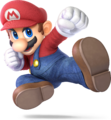 01 Mario
|
Mario is an all-around fighter who uses his wide variety of techniques to respond to any situation. In Super Smash Bros. Ultimate, he shows up in his Wedding tux and his Builder outfit, and Cappy even makes an appearance! | Neutral - Fireball Side - Cape Up - Super Jump Punch Down - F.L.U.D.D. |
Mario Finale | |
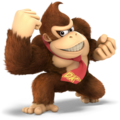 02 Donkey Kong
|
His charged punch is one of the strongest attacks in the game! In Super Smash Bros. Ultimate, his Final Smash has been updated from Konga Beat to a flurry of punches! | Neutral - Giant Punch Side - Headbutt Up - Spinning Kong Down - Hand Slap |
Jungle Rush | |
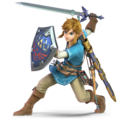 03 Link
|
Link has been redesigned to match his appearance in The Legend of Zelda: Breath of the Wild. He can now pick up arrows he's fired, and his bombs have been upgraded to remote bombs, so you can set them off when the timing is just right! | Neutral - Bow and Arrows Side - Boomerang Up - Spin Attack Down - Remote Bomb |
Ancient Bow and Arrow | |
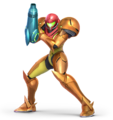 04 Samus
|
With her Charge Shot, Missile and Bomb, Samus has three different projectiles to keep her opponents in check from a distance. When fully charged up, her Charge Shot is quite powerful. For her Final Smash, she launches a wide laser beam that can be moved up and down! | Neutral - Charge Shot Side - Missile Up - Screw Attack Down - Bomb |
Zero Laser | |
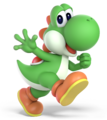 05 Yoshi
|
Yoshi is all about egg-related moves, like throwing eggs, swallowing opponents and turning them into eggs, or turning into an egg and charging toward an opponent. With a high jump, recovery is a piece of cake for Yoshi! And for his Final Smash, a Yoshi army stampedes through the stage. | Neutral - Egg Lay Side - Egg Roll Up - Egg Throw Down - Yoshi Bomb |
Stampede! | |
 06 Kirby
|
Kirby's ability to copy other fighters is totally unique! While he is light and can be launched easily, he can also jump up to five times in the air, so he has great recovery. Look for his new Stone transformation, too. | Neutral - Inhale Side - Hammer Flip Up - Final Cutter Down - Stone |
Ultra Sword | |
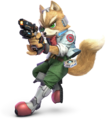 07 Fox
|
He can overwhelm his opponents with his quick movements, and his specials don't leave him open for counterattacks. His costume and voice have been redone to match his appearance in Star Fox Zero. This Fox is brand new! "Come on!" | Neutral - Blaster Side - Fox Illusion Up - Fire Fox Down - Reflector |
Team Star Fox | |
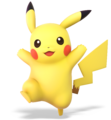 08 Pikachu
|
This fierce fighter uses electric moves like Thunder Jolt and Thunder. Pikachu Libre is one of the alternate costumes and you can tell she's female by the shape of her tail. | Neutral - Thunder Jolt Side - Skull Bash Up - Quick Attack Down - Thunder |
Volt Tackle | |
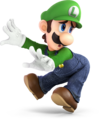 09 Luigi
|
He can jump higher than his brother, Mario. His Up Special, Super Jump Punch, will gain maximum damage and launching power when hitting the opponent right at the start. It truly is a "Special" move. He also uses his new Poltergust for his throw! | Neutral - Fireball Side - Green Missile Up - Super Jump Punch Down - Luigi Cyclone |
Poltergust G-00 | |
How to unlock:
| ||||
 10 Ness
|
Ness has a variety of moves, from long-range attacks using psychic powers known as "PSI," to short-range attacks with his bat and yo-yo. Ness can also unleash PK Thunder, a guided attack that can launch him like a rocket or help him recover! | Neutral - PK Flash Side - PK Fire Up - PK Thunder Down - PSI Magnet |
PK Starstorm | |
How to unlock:
| ||||
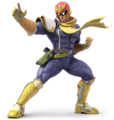 11 Captain Falcon
|
A fighter that possesses both speed and power! But in exchange, he is frequently left open. Being able to successfully land his neutral special, Falcon Punch, can greatly influence the battle in multiplayer matches. | Neutral - Falcon Punch Side - Raptor Boost Up - Falcon Dive Down - Falcon Kick |
Blue Falcon | |
How to unlock:
| ||||
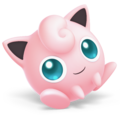 12 Jigglypuff
|
Jigglypuff can jump 5 times in the air and can move faster in the air than on the ground. Use Jigglypuff's great aerial ability to overwhelm your opponent! If you manage to land the down special Rest, you can powerfully launch your opponent. | Neutral - Rollout Side - Pound Up - Sing Down - Rest |
Puff Up | |
How to unlock:
| ||||
 13 Peach
|
THE super princess. Watch out for her powerful kicks while she's airborne. Using her down special, she picks vegetables and throws them at her opponents. Sometimes she even gets items...like a Bob-omb! | Neutral - Toad Side - Peach Bomber Up - Peach Parasol Down - Vegetable |
Peach Blossom | |
How to unlock:
| ||||
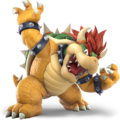 14 Bowser
|
Who's the greatest nemesis of all!? It's King Bowser! In Super Smash Bros, his power and weight make him a reliable fighter. Use his Fire Breath to keep opponents at bay, then use his damaging attacks to launch them off the stage! He transforms into Giga Bowser for his Final Smash and delivers a super powerful punch! | Neutral - Fire Breath Side - Flying Slam Up - Whirling Fortress Down - Bowser Bomb |
Giga Bowser Punch | |
How to unlock:
| ||||
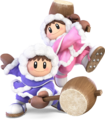 15 Ice Climbers
|
Back in the battle after a ten-year absence! There are two of them, so does that make them twice as strong as other fighters? | Neutral - Ice Shot Side - Squall Hammer Up - Belay Down - Blizzard |
Iceberg | |
How to unlock:
| ||||
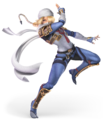 16 Sheik
|
Now Sheik joins the battle wearing the Sheikah costume from The Legend of Zelda: Breath of the Wild. Keep the pressure on your opponent by using his speedy dash to quickly close in on (or get away from) your opponent! | Neutral - Needle Storm Side - Burst Grenade Up - Vanish Down - Bouncing Fish |
Sheikah Dance | |
How to unlock:
| ||||
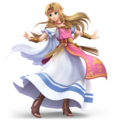 17 Zelda
|
You might recognize Zelda's look from The Legend of Zelda: A Link Between Worlds game. In battle, she uses magical moves to reflect and teleport, and for her Final Smash, she seals her opponents away in the Triforce of Wisdom. If an opponent has 100% damage or more, they will be instantly KO'd! | Neutral - Nayru's Love Side - Din's Fire Up - Farore's Wind Down - Phantom Slash |
Triforce of Wisdom | |
How to unlock:
| ||||
 18 Dr. Mario
|
He has more attack and launch power than Mario, but his jump and recovery is not as good. Pro tip: You can repeatedly press the B button when using his down special, Dr. Tornado, to float a bit! | Neutral - Megavitamin Side - Super Sheet Up - Super Jump Punch Down - Dr. Tornado |
Doctor Finale | |
How to unlock:
| ||||
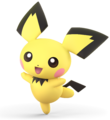 19 Pichu
|
Pichu is back after 17 years! Pichu's electric attacks have greater range and do more damage than its other attack types – but they also damage Pichu. | Neutral - Thunder Jolt Side - Skull Bash Up - Agility Down - Thunder |
Volt Tackle | |
How to unlock:
| ||||
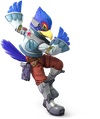 20 Falco
|
He's a talented aerial fighter with amazing jumping ability, but Falco is a bit slower on the ground. His final smash is an all-out attack using an unorthodox formation of Arwings! | Neutral - Blaster Side - Falco Phantasm Up - Fire Bird Down - Reflector |
Team Star Fox | |
How to unlock:
| ||||
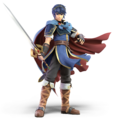 21 Marth
|
Marth is an exceptional swordfighter with a long reach. He'll do the most damage with attacks using the tip of his sword, so spacing is an important factor. | Neutral - Shield Breaker Side - Dancing Blade Up - Dolphin Slash Down - Counter |
Critical Hit | |
How to unlock:
| ||||
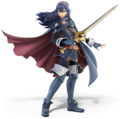 21ε Lucina
|
Lucina is Marth's echo fighter, so she shares most of her standard and special attacks with Marth. However, while Marth's attacks are more powerful when made with the tip of his blade, Lucina's attacks just as powerful whether you use the tip or the base of the sword. | Neutral - Shield Breaker Side - Dancing Blade Up - Dolphin Slash Down - Counter |
Critical Hit | |
How to unlock:
| ||||
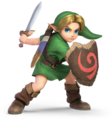 22 Young Link
|
He’s back after 17 years! Young Link is faster than Link but he's also lighter, making him easier to launch. | Neutral - Fire Arrow Side - Boomerang Up - Spin Attack Down - Bomb |
Triforce Slash | |
How to unlock:
| ||||
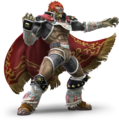 23 Ganondorf
|
His new design matches his appearance in The Legend of Zelda: Ocarina of Time! Now he uses his sword for all his smash attacks. He's a bit slimmer then he was before, but his Warlock Punch is devastating! For his final smash he transforms into Ganon, The Demon King and quickly charges forward. | Neutral - Warlock Punch Side - Flame Choke Up - Dark Dive Down - Wizard's Foot |
Ganon, The Demon King | |
How to unlock:
| ||||
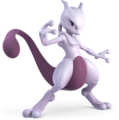 24 Mewtwo
|
A Legendary Pokémon known for its technical moves. Use Confusion or Disable as a diversion, then land a Shadow Ball! For its Final Smash, Mewtwo transforms into Mega Mewtwo Y and fires a projectile that freezes and launches the opponent! | Neutral - Shadow Ball Side - Confusion Up - Teleport Down - Disable |
Psystrike | |
How to unlock:
| ||||
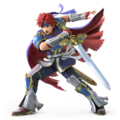 25 Roy
|
Get up close and personal for major damage! Unlike Marth, Roy's attacks are more powerful the closer you get to the base of his blade. For his Final Smash, his sword bursts into flame and sends anyone caught in the blast flying. | Neutral - Flare Blade Side - Double-Edge Dance Up - Blazer Down - Counter |
Critical Hit | |
How to unlock:
| ||||
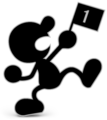 26 Mr. Game & Watch
|
When using his side special, Judge, this fighter pulls out a hammer and the numbers 1-9 are displayed. If you pull off a 9 attack, it will really knock the opponent back. His Final Smash turns him into an octopus that can pull opponents off the stage! | Neutral - Chef Side - Judge Up - Fire Down - Oil Panic |
Octopus | |
How to unlock:
| ||||
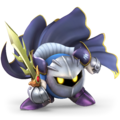 27 Meta Knight
|
This fighter not only has tons of quick moves, he can perform a midair jump five times! All his special moves have a recovery aspect, so use them at the right time. His Final Smash is Darkness Illusion, which unleashes a fast series of aerial attacks. | Neutral - Mach Tornado Side - Drill Rush Up - Shuttle Loop Down - Dimensional Cape |
Darkness Illusion | |
How to unlock:
| ||||
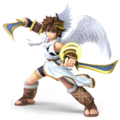 28 Pit
|
Pit is a well-balanced, well-rounded character with a defensive special that nullifies long distance attacks and excellent recovery. He's a great choice for new players! | Neutral - Palutena Bow Side - Upperdash Arm Up - Power of Flight Down - Guardian Orbitars |
Lightning Chariot | |
How to unlock:
| ||||
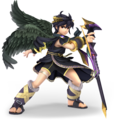 28ε Dark Pit
|
Dark Pit is Pit's echo fighter. His abilities are mostly the same as Pit's, but his hair and clothes are different colors, he summons different weapons, and celebrates victory to a different tune. | Neutral - Silver Bow Side - Electroshock Arm Up - Power of Flight Down - Guardian Orbitars |
Dark Pit Staff | |
How to unlock:
| ||||
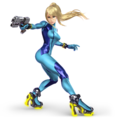 29 Zero Suit Samus
|
Although not as powerful as Samus, her speed is exceptional! Her Paralyzer not only has the ability to stun opponents, but it can also turn into a whip. For her Final Smash, she dons her suit and fires a powerful laser! | Neutral - Paralyzer Side - Whip Lash Up - Boost Kick Down - Flip Jump |
Zero Laser | |
How to unlock:
| ||||
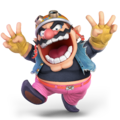 30 Wario
|
Wario has unique attacks, like using his Wario Bike and releasing noxious gas. He can jump higher than normal by leaping from his bike, which comes in handy when recovering. For his Final Smash, he turns into Wario-Man and creates copies of himself for an all-out attack! | Neutral - Chomp Side - Wario Bike Up - Corkscrew Down - Wario Waft |
Wario-Man | |
How to unlock:
| ||||
 31 Snake
|
Back by popular demand, Snake brings a ranged fighting style unlike any other fighter in the game. His Final Smash locks onto an opponent and fires five homing missiles. | Neutral - Hand Grenade Side - Remote Missile Up - Cypher Down - C4 |
Covering Fire | |
How to unlock:
| ||||
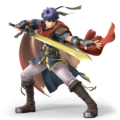 32 Ike
|
Ike's side smash attack is extremely powerful, but it leaves him open, so you'll need to read your opponent's moves carefully. You can choose between his Path of Radiance and Radiant Dawn costumes. | Neutral - Eruption Side - Quick Draw Up - Aether Down - Counter |
Great Aether | |
How to unlock:
| ||||
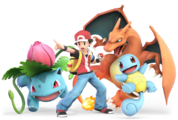 Pokémon Trainer 33 Squirtle / 34 Ivysaur / 35 Charizard
|
Pokémon Trainer returns with Squirtle, Ivysaur and Charizard. You can choose to play as a male or female trainer! | Squirtle Neutral - Water Gun Side - Withdraw Up - Waterfall Ivysaur Neutral - Bullet Seed Side - Razor Leaf Up - Vine Whip Charizard Neutral - Flamethrower Side - Flare Blitz Up - Fly All Down - Pokémon Change |
Triple Finish | |
How to unlock:
| ||||
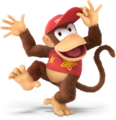 36 Diddy Kong
|
Donkey Kong's trusty partner Diddy Kong uses his light weight and agility to get around quickly! For his Final Smash, Diddy takes to the air with his Rocketbarrel while firing his popguns. The final hit is seriously powerful! | Neutral - Peanut Popgun Side - Monkey Flip Up - Rocketbarrel Boost Down - Banana Peel |
Hyper Rocketbarrel | |
How to unlock:
| ||||
 37 Lucas
|
Like Ness, Lucas is a young boy who uses PSI powers. Some of their PSI moves share the same names, but since Lucas has different abilities, the moves may work differently. Be sure to try them out! For his Final Smash, he calls down a shower of meteors along with Kumatora and Boney. | Neutral - PK Freeze Side - PK Fire Up - PK Thunder Down - PSI Magnet |
PK Starstorm | |
How to unlock:
| ||||
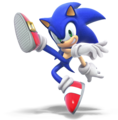 38 Sonic
|
This speedy fighter has a lot of rush-type attacks. His final smash, Super Sonic, lets him fly around the stage at an incredible speed! | Neutral - Homing Attack Side - Spin Dash Up - Spring Jump Down - Spin Charge |
Super Sonic | |
How to unlock:
| ||||
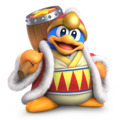 39 King Dedede
|
He's not very fast, but he's one of few heavyweight fighters with great recovery. Apparently, a defeat by Kirby inspired him to train hard to learn a move called Hovering, which allows him to float after taking a deep breath. | Neutral - Inhale Side - Gordo Throw Up - Super Dedede Jump Down - Jet Hammer |
Dede-Rush | |
How to unlock:
| ||||
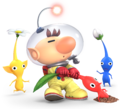 40 Olimar
|
Captain Olimar battles by issuing commands to various types of Pikmin under his control. Pikmin come in different colors that correspond to different abilities. Olimar's alternate appearance lets you play as Alph! | Neutral - Pikmin Pluck Side - Pikmin Throw Up - Winged Pikmin Down - Pikmin Order |
End of Day | |
How to unlock:
| ||||
 41 Lucario
|
Lucario is the only fighter whose attack power increases as it takes damage. A fighter that truly shines when in a pinch, choose Lucario for a thrilling battle. | Neutral - Aura Sphere Side - Force Palm Up - Extreme Speed Down - Double Team |
Aura Storm | |
How to unlock:
| ||||
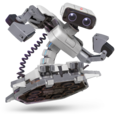 42 R.O.B.
|
He has two powerful projectiles: Robo Beam and Gyro, along with a very effective recovery. The 1P color in the North American version of the game is a light gray, and the 2P is red and white, but this is reversed in the Japanese version. | Neutral - Robo Beam Side - Arm Rotor Up - Robo Burner Down - Gyro |
Guided Robo Beam | |
How to unlock:
| ||||
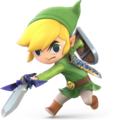 43 Toon Link
|
He's smaller and faster than Link. His bombs explode with a unique anime-style. For his Final Smash, he emits light from his left hand and any opponents hit by it are trapped in the Triforce, subject to a punishing gauntlet of attacks. | Neutral - Hero's Bow Side - Boomerang Up - Spin Attack Down - Bomb |
Triforce Slash | |
How to unlock:
| ||||
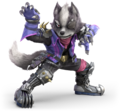 44 Wolf
|
The leader of the Star Wolf mercenary team makes his grand return after 10 years! He puts his sharp claws to good use in wild attacks, and his Final Smash is an all-out attack by Team Star Wolf! If Fox or Falco is in the battle, you may hear a unique line of dialog. | Neutral - Blaster Side - Wolf Flash Up - Fire Wolf Down - Reflector |
Team Star Wolf | |
How to unlock:
| ||||
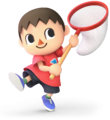 45 Villager
|
This fighter attacks using skills from daily life in the village, such as planting, growing, and cutting down trees. They can also use items like nets, slingshots, and turnips. The Villager can also put items or incoming projectiles in a pocket to use later. | Neutral - Pocket Side - Lloid Rocket Up - Balloon Trip Down - Timber |
Dream Home | |
How to unlock:
| ||||
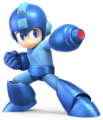 46 Mega Man
|
Mega Man's standard and special moves use weapons copied from the bosses he's fought throughout the Mega Man series, so he has more projectiles than any other fighter. His Final Smash now features Proto Man and Bass! | Neutral - Metal Blade Side - Crash Bomber Up - Rush Coil Down - Leaf Shield |
Mega Legends | |
How to unlock:
| ||||
 47 Wii Fit Trainer
|
A fighter that attacks with healthy moves like stretching and yoga poses. You can pick between male and female versions. Charging up Sun Salutation all the way recovers a bit of health! | Neutral - Sun Salutation Side - Header Up - Super Hoop Down - Deep Breathing |
Wii Fit | |
How to unlock:
| ||||
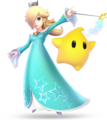 48 Rosalina & Luma
|
Luma mimicks Rosalina's attacks. Luma also increases Rosalina's reach and can even take a hit for her! If Rosalina gets hit, Luma gets very flustered and flutters both hands. | Neutral - Luma Shot Side - Star Bits Up - Launch Star Down - Gravitational Pull |
Grand Star | |
How to unlock:
| ||||
 49 Little Mac
|
As a boxer, Little Mac fights with his fists alone—no kicks! When his Power Meter fills up, he can use a special KO Uppercut, which can really turn a battle around. For his Final Smash, he turns into Giga Mac and pummels the opponent with a furious rush of punches! | Neutral - Straight Lunge Side - Jolt Haymaker Up - Rising Uppercut Down - Slip Counter |
Giga Mac Rush | |
How to unlock:
| ||||
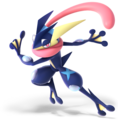 50 Greninja
|
A ninja-like fighter that battles with moves like the Water Shuriken. Greninja can use a log for clever counterattacks, and this Pokémon can even stick to walls. During its Final Smash, it turns into Ash-Greninja...!? | Neutral - Water Shuriken Side - Shadow Sneak Up - Hydro Pump Down - Substitute |
Secret Ninja Attack | |
How to unlock:
| ||||
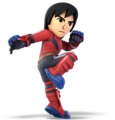 51 Mii Brawler
|
You can choose from the three types of Mii Fighter and select from a set of three specials for each type. You can also choose one of 12 voice options! An expert in physical combat, capable of delivering powerful blows. | Neutral - Shot Put / Flashing Mach Punch / Exploding Side Kick Side - Onslaught / Burning Dropkick / Suplex Up - Soaring Axe Kick / Helicopter Kick / Thrust Uppercut Down - Head-On Assault / Feint Jump / Counter Throw |
Omega Blitz | |
How to unlock:
| ||||
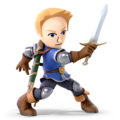 52 Mii Swordfighter
|
You can choose from the three types of Mii Fighter and select from a set of three specials for each type. You can also choose one of 12 voice options! An expert in swordplay with fantastic reach and attack power. | Neutral - Gale Strike / Shuriken of Light / Blurring Blade Side - Airborne Assault / Chakram / Gale Stab Up - Stone Scabbard / Skyward Slash Dash / Hero's Spin Down - Blade Counter / Reversal Slash / Power Thrust |
Final Edge | |
How to unlock:
| ||||
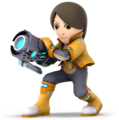 53 Mii Gunner
|
You can choose from the three types of Mii Fighter and select from a set of three specials for each type. You can also choose one of 12 voice options! An expert in long-range projectile combat. | Neutral - Charge Blast / Laser Blaze / Grenade Launch Side - Flame Pillar / Gunner Missile / Stealth Burst Up - Lunar Launch / Cannon Jump Kick / Arm Rocket Down - Echo Reflector / Bomb Drop / Absorbing Vortex |
Full Blast | |
How to unlock:
| ||||
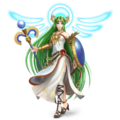 54 Palutena
|
With her wings and staff, this goddess's attacks cover a wide range. With her up smash, neutral special, and side special, she can create a ranged attack in almost every direction except for directly beneath her! Keep the pressure on your opponents from a distance with ranged attacks! | Neutral - Autoreticle Side - Explosive Flame Up - Warp Down - Counter/Reflect Barrier |
Black Hole Laser | |
How to unlock:
| ||||
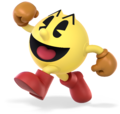 55 Pac-Man
|
This fighter appears in both his classic form and his form with hands and legs. He has many unique special moves, such as using a trampoline or a fire hydrant. For his Final Smash, he grows into a giant Super PAC-MAN, chomping and launching his opponents! | Neutral - Bonus Fruit Side - Power Pellet Up - Pac-Jump Down - Fire Hydrant |
Super PAC-MAN | |
How to unlock:
| ||||
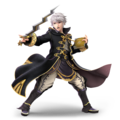 56 Robin
|
A fighter that wields the Levin Sword and four different Tomes! Like in the original game, these weapons can only be used a certain number of times, so keep a close eye on the battle situation. Both the male and female versions of Robin are available, so you can choose your favorite. | Neutral - Thunder Side - Arcfire Up - Elwind Down - Nosferatu |
Pair Up | |
How to unlock:
| ||||
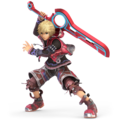 57 Shulk
|
He is the only fighter that can change his status during battle. His sword, the Monado, allows him to switch between five modes—Jump (Green), Speed (Blue), Shield (Yellow), Buster (Purple) and Smash (Red)—which change his abilities for a short time. Fun fact: Shulk's eighth color variation puts him in a pair of swimming trunks! | Neutral - Monado Arts Side - Back Slash Up - Air Slash Down - Vision |
Chain Attack | |
How to unlock:
| ||||
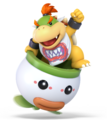 58 Bowser Jr.
|
The Jr. Clown Car this little fella rides in takes less damage when attacked than Bowser Jr. himself—so try to stay in the car when taking damage. The different color variations are the Koopalings! | Neutral - Clown Cannon Side - Clown Kart Dash Up - Abandon Ship! Down - Mechakoopa |
Shadow Mario Paint | |
How to unlock:
| ||||
 59 Duck Hunt
|
This duo excels at long-range attacks, like kicking exploding cans and throwing clay pigeons. For their Final Smash, three games from the Light Gun Series team up: Duck Hunt, Hogan's Alley, and Wild Gunman! | Neutral - Trick Shot Side - Clay Shooting Up - Duck Jump Down - Wild Gunman |
NES Zapper Posse | |
How to unlock:
| ||||
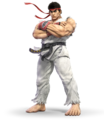 60 Ryu
|
Ryu is a special character—you can use directional command inputs to trigger his special moves. Executing moves like his Hadoken and Shoryuken using the command inputs from the original game will raise their power. You can even use a Shakunetsu Hadoken by inputting ←↙↓↘→ then tapping the attack button while facing right! | Neutral - Hadoken Side - Tatsumaki Senpukyaku Up - Shoryuken Down - Focus Attack |
Shin Shoryuken / Shinku Hadoken | |
How to unlock:
| ||||
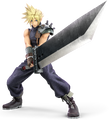 61 Cloud
|
He's the protagonist of Final Fantasy VII. You can also select his Advent Children outfit. Charging up his Limit Gauge increases his special move abilities! Land a powerful hit! | Neutral - Blade Beam Side - Cross Slash Up - Climhazzard Down - Limit Charge / Finishing Touch |
Omnislash / Omnislash Ver. 5 | |
How to unlock:
| ||||
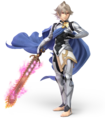 62 Corrin
|
Corrin was available as a downloadable fighter in the previous version of Super Smash Bros. This fighter uses all kinds of attacks, like Torrential Roar and Dragon Fang Shot. Players can choose male or female versions! | Neutral - Dragon Fang Shot Side - Dragon Lunge Up - Dragon Ascent Down - Counter Surge |
Torrential Roar | |
How to unlock:
| ||||
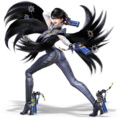 63 Bayonetta
|
An Umbra Witch who equips guns on her arms and legs, Bayonetta has mastered the beautiful but brutal Bullet Arts fighting style. She can even slow down her opponents with Witch Time! | Neutral - Bullet Climax Side - Heel Slide / After Burner Kick Up - Witch Twist Down - Witch Time |
Infernal Climax | |
How to unlock:
| ||||
Newcomers[edit]Base game[edit] | ||||
| Character | Super Smash Blog Description | Special moves | Final Smash | |
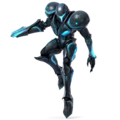 04ε Dark Samus
|
Dark Samus joins the battle as Samus's echo fighter. With floatier movement, she's a little different from Samus--and she doesn't roll when dodging or jumping. If you look closely, you can see that her bombs and missiles look a little different, too. | Neutral - Charge Shot Side - Missile Up - Screw Attack Down - Bomb |
Phazon Laser | |
How to unlock:
| ||||
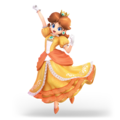 13ε Daisy
|
Her basic move set is the same as Peach's, but this princess has her own unique personality. She's known for being upbeat, energetic, and a bit of a tomboy. | Neutral - Toad Side - Daisy Bomber Up - Daisy Parasol Down - Vegetable |
Daisy Blossom | |
How to unlock:
| ||||
 25ε Chrom
|
The protagonist of Fire Emblem Awakening joins the battle as Roy's echo fighter. His Final Smash is Awakening Aether. Like Aether in the original game, this move has Chrom charge toward his opponent, slashing with his sword. | Neutral - Flare Blade Side - Double-Edge Dance Up - Soaring Slash Down - Counter |
Awakening Aether | |
How to unlock:
| ||||
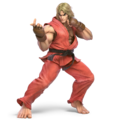 60ε Ken
|
Ken joins the battle as Ryu's Echo Fighter! Their differences are carried over from the original game: Ken's Hadoken is shaped differently, his strong Shoryuken has flames, and he moves a bit faster. He has two Final Smashes: Shinryuken and Shippu Jinraikyaku. | Neutral - Hadoken Side - Tatsumaki Senpukyaku Up - Shoryuken Down - Focus Attack |
Shippu Jinraikyaku / Shinryuken | |
How to unlock:
| ||||
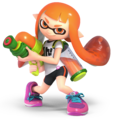 64 Inkling
|
Attacks with a variety of weapons. Covering opponents with ink leads to more and more damage—plus these Inklings are really fashionable! | Neutral - Splattershot Side - Splat Roller Up - Super Jump Down - Splat Bomb |
Killer Wail | |
How to unlock:
| ||||
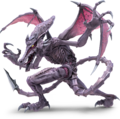 65 Ridley
|
Joining the battle from the storied Metroid series, Ridley's long tail and sharp claws let him unleash a torrent of devastating attacks. His Final Smash is a powerful stream of plasma breath intense enough to bring down Samus's starship. | Neutral - Plasma Breath Side - Space Pirate Rush Up - Wing Blitz Down - Skewer |
Plasma Scream | |
How to unlock:
| ||||
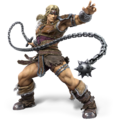 66 Simon
|
The protagonist of Castlevania. He uses his holy whip, Vampire Killer, to perform a smash attack with long reach. He also uses projectiles like an axe, holy water and cross. | Neutral - Axe Side - Cross Up - Uppercut Down - Holy Water |
Grand Cross | |
How to unlock:
| ||||
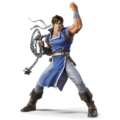 66ε Richter
|
Richter from the Castlevania series joins the battle as Simon's Echo Fighter! His basic attacks are the same as Simon's, but with subtle variations. In addition to that, his Holy Water is a different color. | Neutral - Axe Side - Cross Up - Uppercut Down - Holy Water |
Grand Cross | |
How to unlock:
| ||||
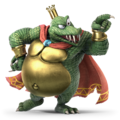 67 King K. Rool
|
With long-distance special moves like the Blunderbuss, and counter moves like Stomach Attack, he is a versatile fighter. His Final Smash, Blast-O-Matic, was apparently a weapon created to destroy DK Island... | Neutral - Blunderbuss Side - Crownerang Up - Propellerpack Down - Gut Check |
Blast-o-Matic | |
How to unlock:
| ||||
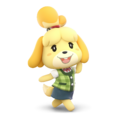 68 Isabelle
|
Isabelle joins the battle from Animal Crossing: New Leaf! She uses various trinkets from around the village to battle. Her side special, "Fishing Rod," not only allows her to snag and bring opponents closer, it can also be used as a recovery move. | Neutral - Pocket Side - Fishing Rod Up - Balloon Trip Down - Lloid Trap |
Dream Town Hall | |
How to unlock:
| ||||
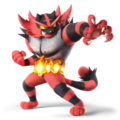 69 Incineroar
|
A fighter with many special moves that appear to come from the world of pro wrestling. Incineroar has many moves from its original game, like Darkest Lariat, Cross Chop, and Revenge. Its Final Smash is Max Malicious Moonsault. Let the Z-Power explode and deliver a powerful blow! | Neutral - Darkest Lariat Side - Alolan Whip Up - Cross Chop Down - Revenge |
Max Malicious Moonsault | |
How to unlock:
| ||||
Downloadable content[edit] | ||||
| Character | Nintendo eShop/DLC website Description | Special moves | Final Smash | |
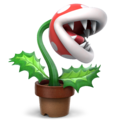 70 Piranha Plant
|
Piranha Plant joins the battle as a stand-alone fighter in the Super Smash Bros. Ultimate game! With its powerful bite, Poison Breath, and ability to call in Petey Piranha for a larger-than-life Final Smash, this fighter's ferocity is as sharp as it teeth. Ready your pipes and flowerpots; your opponent won't see you coming! (Then again, Piranha Plant doesn't really "see" either. It doesn't have eyes.) | Neutral - Ptooie Side - Poison Breath Up - Piranhacopter Down - Long-Stem Strike |
Petey Piranha | |
| Release date: January 29, 2019 (Digital version pre-purchase or My Nintendo); February 1, 2019 (General release) Price: No cost (Digital version pre-purchase or My Nintendo); US$4.99 (after February 1, 2019) | ||||
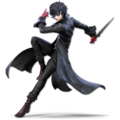 71 Joker
|
Joker steals the show when he joins the Super Smash Bros. Ultimate game as a playable fighter! This speedy fighter wields a knife and a gun to rack up damage. When his Rebellion Gauge is full, Joker summons his Persona, Arsene, to immediately power up his attacks for a limited time. | Neutral - Gun / Gun Special Side - Eiha / Eigaon Up - Grappling Hook / Wings of Rebellion Down - Rebel's Guard / Tetrakarn / Makarakarn |
All-Out Attack | |
| Release date: April 17, 2019 Price: US$5.99 (Challenger Pack 1); US$24.99 (Fighters Pass) | ||||
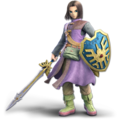 72 Hero
|
The Hero from the DRAGON QUEST series joins Super Smash Bros. Ultimate as a playable fighter! Wielding the Supreme Sword of Light and a trusty shield, he can slice his foes and block incoming attacks. When Hero pulls up his Command Selection screen, he’ll have access to a random selection of spells that could turn the tide of battle in his favor! | Neutral - Frizz / Frizzle / Kafrizz Side - Zap / Zapple / Kazap Up - Woosh / Swoosh / Kaswoosh Down - Command Selection |
Gigaslash | |
| Release date: July 30, 2019 Price: US$5.99 (Challenger Pack 2); US$24.99 (Fighters Pass) | ||||
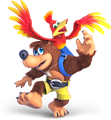 73 Banjo & Kazooie
|
The missing piece of the puzzle is found as Banjo & Kazooie join Super Smash Bros. Ultimate as a playable fighter! With Banjo’s bare hands to bruise rivals up close and Kazooie’s egg-cellent shooting skills, your rivals will be singing the blues in no time. For their Final Smash, these perfect partners call upon a flock of Jinjos and the Mighty Jinjonator to deal the final blow to any “feeble jerk” that may stand in their way! | Neutral - Egg Firing / Breegull Blaster Side - Wonderwing Up - Shock Spring Jump Down - Rear Egg |
The Mighty Jinjonator | |
| Release date: September 4, 2019 Price: US$5.99 (Challenger Pack 3); US$24.99 (Fighters Pass) | ||||
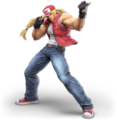 74 Terry
|
Terry Bogard faces the fury in the Super Smash Bros. Ultimate game as a new playable fighter! This iconic fighter from the Fatal Fury series of fighting games is the fourth fighter in the Super Smash Bros. Ultimate Fighters Pass. Using his Power Wave and Burning Knuckle, earn your title as The King of Fighters! | Neutral - Power Wave Side - Burning Knuckle / Crack Shoot Up - Rising Tackle Down - Power Dunk Super Special Move 1 - Power Geyser Super Special Move 2 - Buster Wolf |
Triple Wolf | |
| Release date: November 6, 2019 Price: US$5.99 (Challenger Pack 4); US$24.99 (Fighters Pass) | ||||
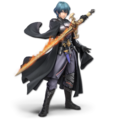 75 Byleth
|
Byleth is coming to the Super Smash Bros. Ultimate game as a new playable fighter! This iconic fighter is the fifth fighter in the Super Smash Bros. Ultimate Fighters Pass. Using the Heroes’ Relics and the Sword of the Creator, represent the three houses and realize their full potential. | Neutral - Failnaught Side - Areadbhar Up - Sword of the Creator Down - Amyr |
Progenitor God Ruptured Heaven | |
| Release date: January 28, 2020 Price: US$5.99 (Challenger Pack 5); US$24.99 (Fighters Pass) | ||||
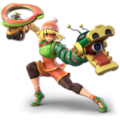 76 Min Min
|
Min Min from the ARMS game is coming to the Super Smash Bros. Ultimate game as a new playable fighter! This iconic fighter is the first fighter in the Super Smash Bros. Ultimate Fighters Pass Vol 2 DLC. Spring into action using the Ramram, Megawatt, and Dragon ARMS to keep your opponents at bay, distance is the key! | Up - ARMS Jump / ARM Hook Down - ARMS Change |
ARMS Rush | |
| Release date: June 29, 2020 Price: US$5.99 (Challenger Pack 6); US$29.99 (Fighters Pass Vol. 2) | ||||
 77 Steve
|
Steve & Alex from the Minecraft game are coming to the Super Smash Bros. Ultimate game as a new playable fighter! This iconic fighter is the second fighter in the Super Smash Bros. Ultimate Fighters Pass Vol 2 DLC. Use Steve and Alex’s various tools to mine and craft your way to victory! | Neutral - Mine / Craft / Create Block Side - Minecart Up - Elytra Down - TNT |
House of Boom | |
| Release date: October 13, 2020 Price: US$5.99 (Challenger Pack 7); US$29.99 (Fighters Pass Vol. 2) | ||||
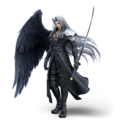 78 Sephiroth
|
Sephiroth, armed with his ruthless Masamune sword and a desire to destroy, joins the Super Smash Bros. Ultimate game as a part of the Super Smash Bros. Ultimate Fighters Pass Vol 2 DLC! This silver-haired swordsman is Cloud's arch nemesis and one of the most iconic villains in gaming. Don't be fooled by his chillingly calm demeanor, his hard-hitting style can deal some white-hot damage. | Neutral - Flare / Megaflare / Gigaflare Side - Shadow Flare Up - Blade Dash / Octoslash Down - Scintilla |
Supernova | |
| Release date: December 22, 2020 (available early from December 17, 2020 by clearing the Sephiroth Challenge) Price: US$5.99 (Challenger Pack 8); US$29.99 (Fighters Pass Vol. 2) | ||||
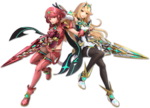 79 Pyra / 80 Mythra
|
Pyra/Mythra from the Xenoblade Chronicles 2 game join the Super Smash Bros. Ultimate game as part of the Fighters Pass Vol 2 DLC! Pyra hits with incredible power and Mythra boasts extreme speed. Swap between the two at any point during battle—or just stick with one. | Pyra Neutral - Flare Nova Side - Blazing End Up - Prominence Revolt Down - Swap to Mythra Mythra Neutral - Lightning Buster Side - Photon Edge Up - Ray of Punishment / Chroma Dust Down - Swap to Pyra |
Burning Sword (Pyra) Sacred Arrow (Mythra) | |
| Release date: March 4, 2021 Price: US$5.99 (Challenger Pack 9); US$29.99 (Fighters Pass Vol. 2) | ||||
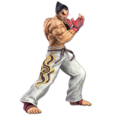 81 Kazuya
|
From the Tekken series, Kazuya Mishima brings his demonic DNA into the fray as a DLC fighter in the Super Smash Bros. Ultimate game. Kazuya’s fighting style captures the distinct style of the Tekken series as he gets up close and personal with heavy strikes and incredible comeback power. His specials tap into his Devil Gene with moves like the beam-shooting Devil Blaster and high-flying Devil Wings. The son of Tekken icon Heihachi Mishima, Kazuya has a chip on his shoulder and destructive power. | Neutral - Devil Blaster Side - Devil Fist Up - Devil Wings Down - Heaven's Door |
Final Blaster | |
| Release date: June 29, 2021 Price: US$5.99 (Challenger Pack 10); US$29.99 (Fighters Pass Vol. 2) | ||||
 82 Sora
|
Sora from the KINGDOM HEARTS series joins the Super Smash Bros. Ultimate roster! Wielding his Keyblade and an arsenal of spells, Sora is a veteran when it comes to battling enemies and is ready to bring his 3-hit combos and aerial style into the fray. | Neutral - Magic Side - Sonic Blade Up - Aerial Sweep Down - Counterattack |
Sealing the Keyhole | |
| Release date: October 18, 2021[6] Price: US$5.99 (Challenger Pack 11); US$29.99 (Fighters Pass Vol. 2) | ||||
Other[edit] | ||||
| Character | Notes | Standard attacks | Special moves | |
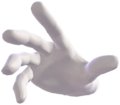 Master Hand
|
Master Hand makes a brief playable appearance in the ending of World of Light, where he is playable in the penultimate level before fighting Galeem and Dharkon. In this battle similar to a round of Mob Smash, Master Hand must take out 50 light and dark puppets of various fighters. Unlike regular fighters, Master Hand starts with 700 HP instead of 0% damage, where losing all of his HP results in failure. He also can fly around the stage. The player can use eight different moves as Master Hand, which are derived from his boss counterpart. Once all 50 puppet fighters are defeated, the battle is over and Master Hand is no longer playable. | Neutral - Finger Snap Side - Slap Up - Drill Down - Paper Crush |
Neutral - Finger Gun Side - Chakram Up - Iron Ball Roll Down - Finger Beam | |
Alternate characters and gender swaps[edit]
Several characters can change their gender in their alternate costumes, while other characters have alternate costumes that turn them into completely different characters. In the latter case, the game recognizes these characters individually as they get announcer calls, crowd chants, and Boxing Ring titles (except for Hero in the former two), but in-game, they have the same attributes as their default character.
Female Pokémon Trainer
Alph
(Olimar)Male Wii Fit Trainer
Female Robin
Larry
(Bowser Jr.)Roy
(Bowser Jr.)Wendy
(Bowser Jr.)Iggy
(Bowser Jr.)Morton
(Bowser Jr.)Lemmy
(Bowser Jr.)Ludwig
(Bowser Jr.)Female Corrin
Inkling Boy
Hero (Dragon Quest III)
(Hero)Hero (Dragon Quest IV)
(Hero)Hero (Dragon Quest VIII)
(Hero)Female Byleth
Alex
(Steve)Zombie
(Steve)Enderman
(Steve)
Bosses[edit]
All Light Realm and Dark Realm bosses, except for Galeem and Dharkon, appear as Classic Mode bosses as well. The stage bosses listed are found in Gaur Plain, Wily Castle, and Find Mii respectively.
Light Realm bosses[edit]
| Image | Name | Description |
|---|---|---|
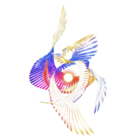
|
Galeem |
The first antagonist of the World of Light mode, Galeem controls the Master Hands and uses light-based attacks, such as a blue orb of energy, laser beams, and mines that explode in a plus formation. Galeem can also use its wings to drill the player. When fought with Dharkon, Galeem will occasionally attack Dharkon instead of the player. |
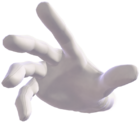
|
Master Hand |
An army of Master Hands serve Galeem in the World of Light mode. Master Hand attacks by poking and slapping the player, drilling and flying into the arena, and occasionally using magical attacks. Master Hand can also throw spiked balls and blobs of ink at the arena. |
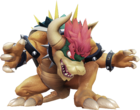
|
Giga Bowser |
Giga Bowser is a monstrous version of Bowser that is immune to flinching. Instead of being launched, Giga Bowser's HP bar must be depleted to zero. Giga Bowser possesses all of Bowser's abilities, which are now even stronger but are slower to start. |
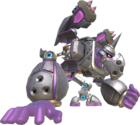
|
Galleom |
Galleom is a giant transforming mecha, possessing both a tank form and an ape-like robot mode. Its attacks include grabbing and crushing the player, firing six homing missiles in tank mode, jumping and stomping the ground, and charging across in tank mode; occasionally making a u-turn to hit the player again. When on low health, Galleom will stomp around in a tantrum, and gain faster attacks. |
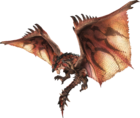
|
Rathalos | Rathalos is a giant wyvern that can fly, breath fire, and swipe using its poisonous claws. Rathalos also can roar, dizzying the player. Rathalos' weak points are its tail and breaking through its hide, which may cause it to drop an item and become stunned respectively. |
Dark Realm bosses[edit]
| Image | Name | Description |
|---|---|---|
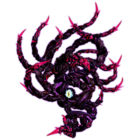
|
Dharkon |
The second antagonist of the World of Light mode, Dharkon controls the Crazy Hands and can use its tentacles to attack the player, as well as darkness based attacks such as two giant energy waves. When fought with Galeem, Dharkon will occasionally attack Galeem instead of the player. |
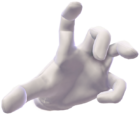
|
Crazy Hand |
An army of Crazy Hands serve Dharkon in the World of Light mode. Crazy Hand uses many of the same attacks as Master Hand, but is much more chaotic and unpredictable in his attack pattern, and he has some unique attacks such as spawning bombs and flailing on the ground. |
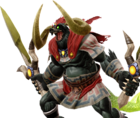
|
Ganon |
Ganon is a demonic pig monster wielding two gigantic swords. Ganon can use his swords to spin and slash the player, and can also summon fire, lightning and malevolent energy. Ganon can only be damaged by striking his tail. |

|
Marx |
Marx is a colorful bat creature with a wide array of elemental attacks, as well as teleportation powers. Marx can launch crescent blades, create seeds that form giant thorny plants, spit an ice chunk that spreads horizontally, can split apart to form a black hole, and can fire a giant darkness laser at the player. |
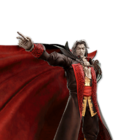
|
Dracula |
Dracula is a boss with two different forms: a humanoid vampire and a green demon. His first form can summon fire and darkness and can transform into a swarm of bats to travel around. His final form gains claw based attacks, can summon ghosts to chase the player, and can cause jumping shockwave attacks. |
Stage bosses[edit]
| Image | Name | Description |
|---|---|---|
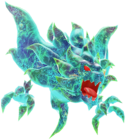
|
Dark Emperor |
The Dark Emperor is a giant bird monster appearing in Find Mii. He can use magic to lower or increase a player's offensive, defensive, or speed stats. His attacks include causing an earthquake that will temporarily destroy platforms on the stage, flying into the stage to collide with players, and roaring which launches players far away. When defeated, he grants large stat boosts to whoever finished him. |
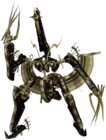
|
Metal Face |
Metal Face is a humanoid robot that has a chance to show up at nightfall in Gaur Plain. His attacks are a giant claw swipe, a platform-destroying laser, and a giant dash attack when he leaves the stage. If Metal Face is defeated, he will burst into a series of explosions that damage the other fighters on the stage. |
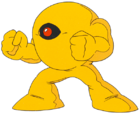
|
Yellow Devil |
A yellow robot present at Wily Castle with the ability to split into yellow blobs which barrage the player, as well as an eye laser attack. Its red eye is its weak point, and when having taken enough damage, it causes a damaging explosion that can be used against other fighters. |
Minor bosses[edit]
| Image | Name | Description |
|---|---|---|

|
Fighting Mii Team |
A horde of Mii Fighters which swarm the player. They possess all the basic abilities of the three types of Mii Fighter. They have limited AI in most modes but are stronger in Cruel Smash. |
Stages[edit]
Unlike in previous installments, stages are selected before characters in Super Smash Bros. Ultimate. All stages can not only be played in their Final Destination form (known as Omega (Ω) form) as in Super Smash Bros. for Nintendo 3DS / Wii U, but also in a new Battlefield form, which adds three floating, pass-through platforms. Like the original Final Destination and Battlefield, in both forms for all stages, the stage is set on a large platform floating over an abyss, as opposed to a large pillar with walls leading down to the bottom, as is the case with several Omega stages in the previous installments. The player is also given the option to turn off stage hazards.
A new feature added to Super Smash Bros. Ultimate is Stage Morph, which causes the stage on which players are currently fighting to transform into another stage in the middle of the match. The player can choose two stages for this function, and can also set the frequency at which they transform between each other.
There are 103 stages in the base game, all of which are available from the start. There are also twelve stages released through DLC, with each DLC fighter (except Piranha Plant) having a stage of their own, and the addition of Small Battlefield in the version 8.1.0 update, adding up to 116 stages, the most of any game in the series. The following list is sorted by the original Super Smash Bros. games in which they first appear. Stages marked with an asterisk (*) are downloadable content.
New[edit]
Super Smash Bros.[edit]
Super Smash Bros. Melee[edit]
Super Smash Bros. Brawl[edit]
Super Smash Bros. for Nintendo 3DS / Wii U[edit]
Nintendo 3DS version[edit]
Wii U version[edit]
Items[edit]
New[edit]
Returning[edit]
Assist Trophies[edit]
New[edit]
Returning[edit]
Poké Ball Pokémon[edit]
New[edit]
Returning[edit]
Nintendo Labo VR[edit]
After downloading the version 3.1.0 update released on May 30, 2019, the Nintendo Labo's Toy-Con VR Goggles can be used in the "VR" mode (found in "Games & More"), which allows a single player to play regular matches against CPUs or spectate CPU-controlled matches in virtual reality.[7] VR mode does not include the same rules and stages as Smash mode, as only Time matches of up to 10 minutes can be played, and only the CPU levels, launch rates, score/damage displays, and stage selection mode can be modified. Items also cannot be used.
The following 50 stages are available in VR:
Update history[edit]
Note that the most recently released software update must be downloaded to access Online. In addition, most updates invalidate replay data created before that update, making them unplayable, due to replays reading game data and inputting recordings of data live, rather than actual footage. Release dates are in Pacific Standard Time.[8][9]
1.1.0[edit]
Release date: December 7, 2018
- Offline Gameplay
- Added a Hard difficulty to Adventure mode.
- Incorporated team colors when fighting false characters in the final battle.
- Online Gameplay
- Online now includes Quickplay, Battle Arenas, Spectate, and Background Matchmaking.
- Global Smash Power will now be displayed.
- Note that the above requires a Nintendo Switch Online membership.
- Game Data Adjustments
- The ability to receive spirit event data has been added.
- The ability to receive presents has been added.
- DLC
- The Fighters Pass special bonuses, based on the character Rex from Xenoblade Chronicles 2, have been added. Said bonus items are listed below:
- Rex Wig (Mii Fighter headgear, usable by all Mii Fighter types)
- Rex Outfit (Mii Swordfighter outfit)
- The Fighters Pass special bonuses, based on the character Rex from Xenoblade Chronicles 2, have been added. Said bonus items are listed below:
- Miscellaneous
- Game balance adjustments
- Various gameplay fixes
1.2.0[edit]
Release date: December 13, 2018
- Offline Gameplay
- Adjusted difficulty of approaching challengers.
- Online Gameplay
- When matchmaking in Quickplay, the Format setting of one's Preferred Rules will be more highly prioritized. This may cause matchmaking to take more time, and there's still no guarantee that players find a match that has their exact Preferred Rules.
- Increased the stability of the synchronous connection within Battle Arenas.
NOTE: Online features require a Nintendo Switch Online membership.
- Misc.
- Game balance adjustments.
- The fighters that had specific adjustments are listed below.
- Donkey Kong, Link, Kirby, Luigi, Ice Climbers, Young Link, Olimar, Toon Link, Villager, Greninja, Pac-Man, Duck Hunt, and Isabelle
- Bug fixes
- The player can no longer Z-drop items out of hitstun, weakening characters who were previously able to escape true combos by dropping their items.
- Fixed a glitch causing the 0.85× damage multiplier for short-hopped aerial attacks to still be active during a full hop if the player performed a short hop and landed without attacking out of it.
1.2.1[edit]
Release date: December 21, 2018
- Misc.
- Game balance adjustments.
- Various gameplay fixes.
2.0.0[edit]
Release date: January 30, 2019
- Offline Gameplay
- Spirit Board can now be played with up to four players offline
- The following spirits can now appear in the shop:
- Partner Pikachu
- Partner Eevee
- Dice Block
- River Survival
- Golden Dash Mushroom
- Online Mode
- GSP calculation method has been adjusted
- General
- Piranha Plant added as a playable fighter, a fighter spirit, and two smash tags. This content is DLC.
- Pressing both jump buttons now inputs a short hop.
- Fixed an issue where the KO score included one's teammate KO when Team Attack is on.
- Characters now respawn in the center of omega-form stages instead of to the left.
- Bug fixes
- Patched out the infinite Assist Trophy glitch.
- Fixed a glitch where if Olimar had any Attack-increasing Spirits equipped, the Attack multiplier would be applied twice for any of his attacks involving Pikmin, causing extremely large damage outputs.
- The song "Bein' Friend" was renamed "Bein' Friends".
- Game-balance adjustments.
- Misc.
- The fighters that had specific adjustments are listed below:
- Mario, Donkey Kong, Link, Samus, Dark Samus, Yoshi, Kirby, Pikachu, Luigi, Ness, Jigglypuff, Peach, Daisy, Bowser, Ice Climbers, Sheik, Pichu, Ganondorf, Mewtwo, Roy, Chrom, Mr. Game & Watch, Pit, Zero Suit Samus, Wario, Snake, Ike, Pokémon Trainer (Charizard), Diddy Kong, Lucas, Sonic, King Dedede, Lucario, R.O.B., Toon Link, Mega Man, Rosalina & Luma, Little Mac, Greninja, Palutena, Pac-Man, Robin, Shulk, Duck Hunt, Ryu, Ken, Cloud, Corrin, Bayonetta, Inkling, Ridley, King K. Rool, Isabelle, Incineroar, Mii Brawler, and Mii Gunner[10]
- Reversed the function of hiding models when the camera gets too close to the fighters in camera mode.
- Various gameplay fixes.
- The fighters that had specific adjustments are listed below:
2.0.1[edit]
Release date: February 22, 2019
- General
- Bug fixes
- A bug where the King K. Rool Adventure Challenge would not be noted as "completed", even if the player has completed said challenge, has been fixed.
- Bug fixes
- Misc.
- Various gameplay fixes.
2.0.2[edit]
Release date: April 2, 2019[11]
- Offline Gameplay
- Added compatibility with the Young Link, Daisy, and Ken amiibo from the Super Smash Bros. line.
3.0.0[edit]
Release date: April 17, 2019
- Offline Gameplay
- Stage Builder added.
- DLC Spirit Board added. The spirits on this spirit board are only available to those who have downloaded applicable DLC, and these spirits never leave the board. The following spirits, based on characters from Persona 5, are available on the DLC Spirit Board for those who have downloaded Challenger Pack 1:
- Phantom Thieves of Hearts
- Igor
- Caroline & Justine
- Morgana
- Ryuji Sakamoto
- Ann Takamaki
- Yusuke Kitagawa
- Makoto Niijima
- Futaba Sakura
- Haru Okumura
- Goro Akechi
- If Challenger Pack 1 has been downloaded, the Joker (Student) Fighter Spirit can appear in the Vault Shop.
- Replays that have been converted into videos can now be edited.
- Online Gameplay
- Stages, Mii Fighters, replays, and videos can now be uploaded online and downloaded.
- Synchronization with Smash World (a service available through the Nintendo Switch Online mobile app) is now possible.
- Players with similar Global Smash Power are matched more often in Quickplay.
- General
- Joker added as a playable fighter, two fighter spirits (Joker (Phantom Thief) and Joker (Student)), and two smash tags. Challenger Pack 1 is required to access this content.
- Mementos added as a stage, with music from the Persona series (Challenger Pack 1 required).
- Chrom's victory theme changed to a partial remix of the Fire Emblem: Awakening music "Id (Purpose)", which also serves as the victory theme for Lucina and Robin.
- The announcer now calls out "Stamina Battle" in the character select screen for stamina-type matches.
- DLC items for Mii Fighters are available:
- Persona 3 Protagonist Wig
- Persona 3 Protagonist Outfit (exclusive to Swordfighters)
- Persona 4 Protagonist Wig
- Persona 4 Protagonist Outfit (exclusive to Swordfighters)
- Teddie Hat
- Morgana Hat
- Tails Hat
- Tails Outfit (exclusive to Gunners)
- Knuckles Hat
- Knuckles Outfit (exclusive to Brawlers)
- Miscellaneous
- Game balance adjustments.
3.0.1[edit]
Release date: April 25, 2019
- General
- Bug fixes
- Fixed a bug that caused the game to freeze when Joker's Final Smash is used in Classic Mode.
- Bug fixes
3.1.0[edit]
Release date: May 30, 2019
- Offline Gameplay
- Added support for the Nintendo Labo: VR Kit, alongside the new VR mode.
- Online Gameplay
- amiibo can be used in Battle Arenas.
- Added an option for the amiibo to send on a journey, which the figure player train with other figure players via the internet.
- Preferred rules for Quickplay have been adjusted.
- General
- Game balance adjustments.
4.0.0[edit]
Release date: July 30, 2019
- Offline Gameplay
- Very Easy difficulty has been added to Adventure mode.
- Snapshots can be added to the timeline in Edit Video.
- Steel, grass, sponge, paper, and yarn terrains have been adjusted in Stage Builder.
- Following spirits added to the DLC Spirit Board if the player has downloaded Challenger Pack 2.
- Slime
- enhances to King Slime
- Dracky
- Great Sabrecub
- Golem
- Liquid Metal Slime
- Cetacea
- Hero's Comrades
- Slime
- Online Gameplay
- Online Tourney Mode has been added.
- The player can predict who wins a Spectate Battle and earn points.
- Videos can be played repeatedly in Shared Content. Also, whenever you save posted content, a Yeah! will be added automatically.
- General
- Hero is now a playable fighter, four fighter spirits (Hero (DRAGON QUEST XI S), Hero (DRAGON QUEST III), (Hero (DRAGON QUEST IV), and Hero (DRAGON QUEST VIIII)) have been added. Challenger Pack 2 is required to access this content.
- Yggdrasil's Altar added as a stage with music from the Dragon Quest series. (Challenger Pack 2 required)
- DLC items for Mii Fighters are available:
- Erdrick's Helmet + Armor
- Martial Artist Wig + Gi
- Veronica's Hat + Outfit
- Slime Hat
- When the FS Meter is fully charged, the player will need to use it in a set amount of time before it ends.
- Hero is now a playable fighter, four fighter spirits (Hero (DRAGON QUEST XI S), Hero (DRAGON QUEST III), (Hero (DRAGON QUEST IV), and Hero (DRAGON QUEST VIIII)) have been added. Challenger Pack 2 is required to access this content.
5.0.0[edit]
Release date: September 4, 2019
- Offline Gameplay
- Home-Run Contest has been added
- Milestones related to Home-Run Contest added.
- Players who have save data for Dragon Quest XI S: Echoes of an Elusive Age - Definitive Edition or its demo on their Switch will be gifted with the Tockles spirit.
- The following spirits will appear in the DLC Spirit Board if the player has downloaded Challenger Pack 3:
- Tooty
- Bottles
- Mumbo Jumbo
- Jinjos
- enhances to The Mighty Jinjonator
- Jiggy
- Gruntilda
- Buzzbomb
- Home-Run Contest has been added
- General
- Banjo & Kazooie are now a playable fighter, and one new fighter spirit (Banjo & Kazooie) has been added. Challenger Pack 3 needed to access this content.
- Spiral Mountain added as a stage, with new music tracks from the Banjo-Kazooie series (Challenger Pack 3 needed).
- DLC items for Mii Fighters are available:
- Team Rocket Hat + Outfit
- Sans Mask + Outfit + MEGALOVANIA track
- Goemon Wig + Outfit
- Proto Man's Helmet + Armor
- Zero's Helmet + Armor
- Banjo & Kazooie are now a playable fighter, and one new fighter spirit (Banjo & Kazooie) has been added. Challenger Pack 3 needed to access this content.
6.0.0[edit]
Release date: November 6, 2019
- Offline Gameplay
- The following spirits will appear in the DLC Spirit Board if the player purchased Challenger Pack 4:
- Andy Bogard
- Joe Higashi
- Kim Kaphwan
- Geese Howard
- Ryo Sakazaki
- Kyo Kusanagi
- Iori Yagami
- Haohmaru
- Nakoruru
- Athena Asamiya
- Ralf & Clark
- The Tockles Spirit will now appear on the Dragon Quest Spirit Board, as well as in the Vault Shop. (Challenger Pack 2 needed to access the Dragon Quest Spirit Board).
- The following spirits will appear in the DLC Spirit Board if the player purchased Challenger Pack 4:
- Online Gameplay
- The following features have been added to Battle Arena mode:
- The "Elite Only" arena type has been added
- Friend's arenas can now be found more easily
- The Host player can now change some rules without having to exit the arena
- The option to choose which form the stage can be in has been added
- The player can now send set messages to other people inside the arena
- The following features have been added to Battle Arena mode:
- General
- Added support for the upcoming Simon and Incineroar amiibo figures.
- Terry is now an available fighter, one new fighter spirit (Terry Bogard) has been added. Challenger Pack 4 is needed to access this content
- King of Fighters Stadium stage has been added, with new music tracks from several SNK series.
- DLC items for Mii Fighters are available:
- Ryo Sakazaki Wig + Outfit
- Nakoruru Wig + Outfit
- Iori Yagami Wig + Outfit
- Akira Wig + Outfit
- Jacy Wig + Outfit
6.1.0[edit]
Release date: December 14, 2019
- General
- Fixed an issue where Terry's Super Special Move "Buster Wolf" connects with an opposing fighter, causing both players to be unable to move.
6.1.1[edit]
Release date: January 7, 2020
- General
- Added support for the upcoming Dark Samus and Richter amiibo figures.
7.0.0[edit]
Release date: January 28th, 2020 (January 29th in some time zones)
- Offline Gameplay
- The following spirits will appear in the DLC Spirit Board if the player purchased Challenger Pack 5:
- Edelgard
- Dimitri (Fire Emblem)
- Claude
- Sothis
- Rhea
- Seteth
- Dorothea
- Ingrid
- Hilda (Fire Emblem)
- The following spirits will appear in the DLC Spirit Board if the player purchased Challenger Pack 5:
- General
- Byleth is now an available fighter, and two new fighter spirits (Byleth (Male) and Byleth (Female)) have been added. Challenger Pack 5 is needed to access this content.
- The Garreg Mach Monastery stage has been added, with new music tracks from Fire Emblem: Three Houses.
- DLC items for Mii Fighters are available:
- Rabbid Hat
- Altaïr Ibn-La'Ahad|Altaïr Hat + Outfit
- X (Mega Man) Helmet
- MegaMan.EXE Helmet + Armor
- Cuphead Mask + Outfit + Floral Fury track
- The special bonus for the Fighters Pass Vol. 2, the Ancient Armor from The Legend of Zelda: Breath of the Wild set for the Mii Swordfighter, has been added.
- The Techniques menu has been updated with three new sections for Failnaught, Sword of the Creator, and Aymr. They are the 90th, 91st, and 92nd options.
- Four new Smash Tag icons have been added, all relating to Byleth: the default male and female skins, and the Enlightened One male and female skins.
- The default music rate for MEGALOVANIA has been increased in all stages it is available on except Hanenbow.
- Byleth is now an available fighter, and two new fighter spirits (Byleth (Male) and Byleth (Female)) have been added. Challenger Pack 5 is needed to access this content.
- Misc
- The Dimitri and Hilda spirits in the base game were renamed to “Dimitri (The Legend of Zelda)” and “Hilda (The Legend of Zelda)” respectively to differentiate them from the Dimitri (Fire Emblem) and Hilda (Fire Emblem) spirits.
- Game balance adjustments have been made.
- The fighters that had specific adjustments are listed below.
- Samus, Dark Samus, Captain Falcon, Sheik, Zelda, Dr. Mario, Young Link, Zero Suit Samus, Toon Link, Mii Brawler, Palutena, Duck Hunt, Ryu, Ken, Cloud, Incineroar, Joker.[12]
8.0.0[edit]
Release date: June 29th, 2020 (June 30th in some time zones)
- General
- The following content is now available for purchase:
- Challenger Pack 6
- Character: Min Min
- Stage: Spring Stadium
- Music: ARMS music
- Ninjara Wig + Outfit
- Heihachi Wig + Outfit
- Callie Wig + Outfit
- Marie Wig + Outfit
- Vault Boy Wig + Outfit
- Challenger Pack 6
- Kirby has been given a new copy ability where he wears Min Min's hair and orange beanie and his usual neutral special is replaced with the dragon version of the punch move. This move can be angled up and down and can fire a laser beam if the button is held down.
- The Techniques menu has been updated with four new sections for "ARM Attack", "Three ARMS in One", "Transforming into a Dragon", and "ARMS Jump / ARM Hook". They are the 93rd, 94th, 95th, and 96th options.
- Three new Smash Tag icons have been added, all relating to Min Min: her default skin, her "black and orange" skin, and her series symbol, an extended fist.
- The following content is now available for purchase:
- Offline
- New features for Spirits mode.
- Rematches/High-scores: Appears on an obtained spirit in the Spirit List, being unlocked by pressing X or + on the controller.
- Completing a rematch will give a score and some spirit points.
- The score and number of spirit points obtained are dependent on the power level of the Spirit Team used in battle.
- Rematches/High-scores: Appears on an obtained spirit in the Spirit List, being unlocked by pressing X or + on the controller.
- The following spirits will appear in the Shop on the Vault menu:
- Master Mummy
- Mechanica
- Byte & Barq
- Kid Cobra
- Helix
- Max Brass
- New features for Spirits mode.
- Misc
- Fountain of Dreams' lag spikes were fixed, however, the lag that comes from Wario turning while using Wario Bike persists.
- Lylat Cruise's ledges were made larger and various collisions near the underside of the stage were modified to make it easier for certain characters to recover.
- Garreg Mach Monastery's Ω and Battlefield forms' lower blast zones and camera bounds were adjusted to match other Ω forms.
- Game balance adjustments have been made.
- The fighters that had specific adjustments are listed below.
- Mario, Kirby, Captain Falcon, Jigglypuff, Ice Climbers, Sheik, Dr. Mario, Falco, Marth, Mewtwo, Meta Knight, Pit, Dark Pit, Zero Suit Samus, Ike, Diddy Kong, Sonic, King Dedede, Olimar, Villager, Mega Man, Wii Fit Trainer, Rosalina & Luma, Little Mac, Palutena, Corrin, Bayonetta, Ridley, King K. Rool, Isabelle, Incineroar, Piranha Plant, Hero, Banjo & Kazooie and Terry.
- Hero's placement in All-Star Smash was changed to match the release date of Dragon Quest III rather than Dragon Quest XI: Echoes of an Elusive Age.
- Fatal Fury's friend icons had their backgrounds changed from red to light blue, matching Terry's page on the Super Smash Bros. Ultimate website.
- Spring Man's friend icon had its background color changed from gray to chartreuse, matching the icons bundled with Min Min.
- Fixed several Sound Test-related oddities, most relating to victory quotes:
- Fox's victory quote against Falco ("Better luck next time, Falco!") is now listed.
- Wolf's victory quote against Fox ("Playtime's over, Star Fox!") is now listed.
- Lucina's victory quote against Ike ("And they call you the Radiant Hero?") is now listed.
- Palutena's victory quote against Pit ("Oh, so sorry about that, Pit.") is now listed.
- Simon's victory quote against dark-related characters ("To darkness!") is now listed.
- Byleth's sound test tags now show the respective gender, much like the rest of the characters with selectable genders and in the Spirit List.
- Balance Changes
8.1.0[edit]
Release date: August 4th, 2020 (August 5th in some time zones)
- Stage
- The Small Battlefield stage has been added. Players can also set Small Battlefield as a Preferred rule in Online battles.
- Players can now select any stage-specific music for the Battlefield, Small Battlefield, Big Battlefield, and Final Destination stages.
- If a particular song is not selected, a random song from all music is chosen based on an average of the My Music settings for each stage.
- Players can no longer access the My Music interface for all four stages from the stage select in Smash Mode, Training, and Mob Smash.
- If a particular song is not selected, a random song from all music is chosen based on an average of the My Music settings for each stage.
- The "Random" option on the Stage Select screen has been split into individual icons for Random, Random Battlefield, and Random Omega.
- Random Custom Stages also has a unique icon now as well.
- Online
- The online user experience has been adjusted.
- The tick rate of 1-on-1 battles not involving spectators has been increased from 30Hz to 60Hz, matching the in-game frame rate. This improves responsiveness but decreases stability on low-quality connections.[13]
- Average input delay of 1-on-1 battles not involving spectators has been reduced from roughly 5 frames to 4 frames.[14]
- The way matching is determined when using Preferred Rules has been adjusted.
- Following a look at the current number of players eligible for Elite Smash, the threshold for entry has been recalculated to allow more players. Additionally, the way initial values for Global Smash Power are calculated has also been adjusted.
- The online user experience has been adjusted.
Further investigations and adjustments to Online mode are expected for future patches.
- General
- Several issues have been fixed to improve the gameplay experience.
- Fixed Min Min's T-Pose glitch.
- Misc
- The display for Spring Man on Spring Stadium's billboard now properly shows his "S" logo instead of Springtron's "T" logo.
- The render of the Question Mark icon has its black border removed in Battle Arenas.[15]
9.0.0[edit]
Release date: October 13th, 2020 (October 14th in some time zones)
- General
- The following content is now available for purchase:
- Challenger Pack 7
- Character: Steve
- Stage: Minecraft World
- Music: Minecraft series music
- Creeper Mask + Outfit
- Pig Mask + Outfit
- Diamond Armor Helmet + Armor
- Gil Helmet + Armor
- Bomberman Mask + Outfit
- Travis Mask + Outfit
- Challenger Pack 7
- Kirby has been given a new copy ability where he becomes completely cuboidal. This appearance is reminiscent of the square Kirby model made by Hal Laboratory as an April Fool's prank in 2019. Kirby's usual neutral special is replaced with the mine ability on the ground and the create block ability while airborne. However, he does not gain the ability to craft at a table.
- The Techniques menu has been updated with six new sections for "Materials and Mining", "Material Gauge", "Craft", "Create Block", "Minecart", and "Elytra". They are the 97th, 98th, 99th, 100th, 101st, and 102nd options.
- Five new Smash Tag icons have been added, all relating to Steve: Steve, Alex, Zombie, Enderman, and his series symbol, a Block.
- The following content is now available for purchase:
- Offline
- The following spirits will appear in the Shop on the Vault menu:
- Zombie
- Creeper
- Skeleton
- Slime (Minecraft)
- Enderman
- Villager & Iron Golem
- Ghast
- Piglin
- Ender Dragon
- The following spirits will appear in the Shop on the Vault menu:
- Online
- The controls during combat in battle arenas while spectators are present have been adjusted
- Adjustments have been made to the way Global Smash Power is calculated.
- Misc
- The Slime spirit added in Version 4.0.0 was renamed to “Slime (Dragon Quest)” to differentiate it from the Slime (Minecraft) spirit.
- Several issues have been fixed to improve the gameplay experience.
- An issue where the movement delay after a perfect shield was behaving incorrectly under certain rules has been fixed.
- Game-balance adjustments, stability fixes, and other minor adjustments have been made.
- The fighters that had specific adjustments are listed below:
- Donkey Kong, Link, Pikachu, Ness, Captain Falcon, Ice Climbers, Sheik, Young Link, Meta Knight, Wario, Ivysaur, Charizard, Sonic, Lucario, Mii Swordfighter, Robin, Shulk, Bowser Jr., Ken, Bayonetta, Ridley, Simon, Richter, Piranha Plant, Banjo & Kazooie, and Min Min.
- Balance Changes
9.0.1[edit]
Release date: October 21st, 2020 (October 22nd in some time zones)
- General
- Several glitches related to Steve have been removed:
- Fixed an issue in which characters could fall through the stage when breaking Blocks.
- Fixed an issue in which characters could fall through the stage when caught between the anvil from Steve's down aerial and a Block.
- Fixed an issue in which fighters could be frozen if hit with Minecart.
- Fixed an issue in which Minecart does not hit opponents when reflected off a wall.
- Fixed an issue in which a fighter caught by Minecart teleports to the position in which they were caught.
- Fixed an issue in which Meta Knight would clip through any terrain which wasn't native to a stage, including those generated by fighters, items and Poké Ball Pokémon after losing a stock.
- Steve's up victory pose was changed to remove the Steak after he eats it.
- Several glitches related to Steve have been removed:
9.0.2[edit]
Release date: November 11th, 2020 (November 12th in some time zones)
- General
- Various glitches that persisted from versions 9.0.0 and 9.0.1 have been removed.
- Fixed an issue where the player could not use the stick to jump while falling after creating an anvil using Steve's down air attack.
- Fixed an issue where the gunman from Duck Hunt's down special and the phantom from Zelda's down special were not behaving as intended.
- Fixed an issue where the initial velocity of Samus's and Dark Samus's Screw Attack, when used on the ground, was not behaving as intended. This allows them to once again reach the top platform on Yoshi's Story.
- Fixed an issue where fighters would sometimes warp on the Venom stage.
- Fixed an issue where sometimes fighters would pass through landscapes when they were launched on some stages.
- Fixed an issue where sometimes the player would be forced to end a battle on a stage created in Stage Builder.
- Various gameplay fixes.
- Various glitches that persisted from versions 9.0.0 and 9.0.1 have been removed.
10.0.0[edit]
Release date: December 17th, 2020 (December 18th, 2020 in some time zones).
- General
- The following content will be available for purchase:
- Challenger Pack 8
- Fighter: Sephiroth
- Music: Final Fantasy music
- Stage: Northern Cave
- Challenger Pack 8
- Kirby has been given a new copy ability where he gains Sephiroth's hair and his Neutral special is replaced with Flare / Megaflare / Gigaflare.
- The Techniques menu has been updated with four new sections for "Wall Stab", "Shadow Flare", "Scintilla", and "Winged Form". They are the 103rd, 104th, 105th, and 106th options.
- Two new Smash Tag icons have been added, both relating to Sephiroth: his original outfit and his coatless outfit.
- Several issues have been fixed to improve the gameplay experience.
- Fixed an issue where getting hit by a Hammer right before Zoroark's final attack connects would result in a fighter getting stuck in midair. Summoning Zoroark again would proceed to crash the game.
- Fixed an issue where some characters would remain at their T-pose model by performing an attack before Zoroark's Fury Swipes.[16]
- Fixed an issue where after using Winged Pikmin, trying to attack in midair with a Pikmin would not work.[17]
- The following content will be available for purchase:
- Sephiroth Challenge: A limited-time event from December 17th-22nd where players can fight Sephiroth on Northern Cave in 3 difficulties: Easy, Normal, and Very Hard. Winning this fight will grant the player access to both ahead of the official release date of December 22nd (December 23rd in some time zones).
- Misc
- The Spirit List now lists Final Fantasy spirits as being from the "FINAL FANTASY Series" rather than "FINAL FANTASY VII".
- The Songs List now lists Final Fantasy music as being from the "FINAL FANTASY VII Series" rather than "FINAL FANTASY VII".
10.1.0[edit]
Release date: December 22nd, 2020 (December 23rd in some time zones).
- General
- The following content will be available for purchase:
- Barret Outfit
- Tifa Outfit
- Aerith Outfit
- Chocobo Hat
- Geno Hat + Outfit
- The player can now switch between "Random from all songs" and "Random from My Music" for the Battlefield, Small Battlefield, Big Battlefield and Final Destination stages.
- To switch between options, the player can access My Music via the Options or the Vault, and then press the X Button.
- The following content will be available for purchase:
- Offline
- The following spirits will appear in the Shop on the Vault menu:
- Tifa
- Barret
- Aerith
- Red XIII
- Cait Sith
- Cid
- Vincent
- Yuffie
- Chocobo & Moogle
- Ifrit
- Shiva
- Bahamut ZERO
- The Turks & Rufus Shinra
- The following spirits will appear in the Shop on the Vault menu:
- Misc
- The player can now switch between "Random from all songs" and "Random from My Music" for the Battlefield, Small Battlefield, Big Battlefield and Final Destination stages.
- To switch between options, access My Music via the Options or the Vault and then press the X Button.
- Sephiroth Challenge is no longer available.
- Cloud obtains a new variant of his Final Smash, Omnislash Ver. 5, if the player chooses one of his Advent Children (P2, P4, P6 and P8) costumes.
- A new entry regarding Omnislash Ver. 5 was added to the Tips, while the tip for regular Omnislash has been slightly changed to accommodate.
- Cloud's Final Smash is now listed as "Omnislash / Omnislash Ver. 5" in the Move List.
- Cloud's fighter spirit for his default costume now uses artwork from Final Fantasy VII, whereas it previously only had his Ultimate art.
- Cloud now has a new Sound Test section with his Advent Children costume, which features the new voice clips used in Omnislash Ver. 5.
- Bayonetta now turns her head during her left-inputted victory pose in the Japanese version of the game, matching the animation on the Global version.
- The fighters that had specific adjustments are listed below:
- Fox, Luigi, Zelda, Pichu, Young Link, Toon Link, Olimar, Rosalina & Luma, Mii Gunner, Duck Hunt
- The player can now switch between "Random from all songs" and "Random from My Music" for the Battlefield, Small Battlefield, Big Battlefield and Final Destination stages.
- Balance Changes
11.0.0[edit]
Release Date: March 4, 2021 (March 5, 2021 in some time zones).
- General
- The following downloadable content will be usable after purchase:
- Challenger Pack 9:
- Fighters: Pyra and Mythra
- Music: Xenoblade Chronicles series music
- Stage: Cloud Sea of Alrest
- Arthur's Helm + Armor
- Felyne Hat
- Hunter's Helm + Mail
- Rathalos Helm + Mail
- Challenger Pack 9:
- The Toad Power-Up Band (amiibo) is now supported.
- If you go to amiibo in Games & More and tap the Toad Power-Up Band, you can receive a reward. The Mario, Luigi, Peach, Daisy, and Yoshi Power-Up Bands can be used as Figure Players.
- Game-balance adjustments have been made. Please see the details of fixes and changes to fighters.
- Several issues have been fixed to improve gameplay experience.
- The following downloadable content will be usable after purchase:
- Offline
- The following spirits will appear in the Shop on the Vault menu:
- Lora
- Amalthus
- Jin
- Malos
- Pheuma
- You can now enhance Rex's spirit.
- When multiple controllers are connected, unused controllers can now be disconnected using other controllers in the fighter-selection screen in Smash.
- This can be done by pressing the A Button over the player bracket of the controller you want to disconnect.
- The following spirits will appear in the Shop on the Vault menu:
11.0.1[edit]
Release date: March 23, 2021 (March 24, 2021 in some time zones).
- General
- Vulnerability when landing after using the Wii Fit Trainer’s side special Header had decreased unintentionally, so this has been adjusted.
12.0.0[edit]
Release date: June 29, 2021 (June 30, 2021 in some time zones).
- General
- The following downloadable content will be usable after purchase:
- Challenger Pack 10:
- Fighter: Kazuya
- Music: Kazuya music
- Stage: Mishima Dojo
- Dante Wig + Outfit
- Shantae Wig + Outfit
- Dragonborn Helm + Outfit
- Lloyd Wig + Outfit
- Challenger Pack 10:
- Game-balance adjustments have been made. Please see the details of fixes and changes to fighters.
- Several issues have been fixed to improve gameplay experience.
- The following downloadable content will be usable after purchase:
- Offline
- The following spirits from the Tekken series will appear in the Shop on the Vault menu:
- Heihachi Mishima
- Jin Kazama
- Jin Kazama's spirit is Enhanceable.
- Kuma & Panda
- Nina Williams
- King & Armor King
- Ling Xiaoyu
- Paul Phoenix & Marshall Law
- Yoshimitsu
- Jack-7
- Asuka Kazama
- The below Spirits will now appear in the Spirit Board and Shop:
- Sophia
- Arthur
- The following spirits from the Tekken series will appear in the Shop on the Vault menu:
13.0.0[edit]
Release date: October 18, 2021 (October 19, 2021 in some time zones).
- General
- The following downloadable content will be usable after purchase:
- Challenger Pack 11:
- Fighter: Sora
- Music: Kingdom Hearts music
- Stage: Hollow Bastion
- Judd Hat
- Octoling Wig
- Doom Slayer Helmet + Armor
- Challenger Pack 11:
- Game-balance adjustments have been made. Please see the details of fixes and changes to fighters.
- Several issues have been fixed to improve gameplay experience.
- The following downloadable content will be usable after purchase:
- Offline
- The following spirits from the KINGDOM HEARTS series will appear in the Shop on the Vault menu:
- Riku
- Kairi
- Roxas
- Axel
- Xion
- Terra
- Ventus
- Aqua
- The following spirits will appear on the Spirit Board and Shop:
- Razewing Ratha
- The following spirits from the KINGDOM HEARTS series will appear in the Shop on the Vault menu:
13.0.1[edit]
Release date: December 1, 2021 (December 2, 2021 in some time zones).
- General
- Game-balance adjustments have been made. Please see the details of fixes and changes to fighters.
- The Samus (Metroid Dread) & E.M.M.I. (Metroid Dread) amiibo are now supported.
- Note: If you go to amiibo in Games & More and tap these amiibo to the NFC area, you can receive their spirits.
- Note: Samus (Metroid Dread) can be used as a Figure Player (FP).
- Several issues have been fixed to improve gameplay experience.
13.0.2[edit]
Release date: February 14, 2024 (February 15, 2024 in some time zones).
- General
- Updates for compatibility with the Sora amiibo, which is scheduled to be released soon.
13.0.3[edit]
Release date: October 8, 2024 (October 9, 2024 in some time zones).
- Online
- Fixed an issue in which Global Smash Power would not return to appropriate levels when the connection was disrupted with specific timing at the end of a match.
- Note: There may be compatibility issues with replays from Ver. 9.0.0 to 13.0.2. Replays from Ver. 8.1.0 and earlier are not compatible. If you want to keep your replays, convert them into videos before installing the update. You can do this via Vault → Replays → Replay Data → Convert to Video.
13.0.4[edit]
Release date: June 24, 2025 (June 25, 2025 in some time zones).
- Offline
- Fixed an issue in which thumbnail images displaying Mii Fighters would sometimes not be generated correctly when creating or modifying a Mii Fighter and saving it in Games & More.
- Related: Online
- The following issues have been fixed in Nintendo Switch 2 system version 20.1.5, released on June 18, 2025:
- When a Nintendo Switch 2 player and a Nintendo Switch player were matched up in online play, the match may have ended immediately if someone was using a Mii Fighter.
amiibo[edit]
- “Have your FP inherit powers from spirits you have.”
- —Text appearing after using amiibo
In addition to all previously released amiibo relating to the playable characters being usable in Super Smash Bros. Ultimate,[3] amiibo for every fighter not in Super Smash Bros. for Nintendo 3DS and Super Smash Bros. for Wii U (including separate figures for the alternate costume fighter Alex, as well as Pokémon Trainer, Squirtle, Ivysaur, Pyra, and Mythra) have been released in the Super Smash Bros. line.[18] Like in Super Smash Bros. for Nintendo 3DS and Super Smash Bros. for Wii U, amiibo can act as Figure Players (FP) in battle, and amiibo data from the aforementioned games can be transferred to Super Smash Bros. Ultimate.[3] Spirits can also be used on Figure Players.
In addition to the fighter amiibo, some other amiibo can summon spirits. For example, if the player uses the Boo amiibo figure, the Boo spirit can be summoned.
The following is a list of released amiibo for fighters introduced in Super Smash Bros. Ultimate:
Released[edit]
December 7, 2018[edit]
February 15, 2019[edit]
April 12, 2019[edit]
July 26, 2019[edit]
September 20, 2019[edit]
November 15, 2019[edit]
January 17, 2020[edit]
October 2, 2020[edit]
March 26, 2021[edit]
April 29, 2022[edit]
September 9, 2022[edit]
January 13, 2023[edit]
July 21, 2023[edit]
February 16, 2024[edit]
Release[edit]
A Super Smash Bros. Ultimate-themed Nintendo Switch Pro Controller has been available since launch; it can be purchased individually or as part of a bundle that also includes the game and a black steel case with the flaming Super Smash Bros. emblem seen in the game's March 2018 teaser.[31][32] A silver 1.5" coin will also be included in the bundle as a bonus item when purchased at Best Buy.[33]
A bundle containing a specially designed Nintendo Switch console and a download code for the game was released on November 2, 2018, though the download code couldn't be used until the game's release on December 7, 2018. The console features a design of the original eight Super Smash Bros. series characters on the front of the dock, as well as the Super Smash Bros. symbol printed across the Joy-Con. A Super Smash Bros. Ultimate-edition Nintendo GameCube Controller and the GameCube Controller Adapter previously released for Super Smash Bros. for Wii U also released on the same day.
Reception[edit]
Critical[edit]
Super Smash Bros. Ultimate has received widespread critical acclaim.
| Reviews | |||
|---|---|---|---|
| Release | Reviewer, Publication | Score | Comment |
| Nintendo Switch | Alex Olney, Nintendo Life |
10/10 | So how does it all stack up? Vocal concerns about past games have been actively addressed, every single fighter from the series is present (even Pichu), the customisability is overwhelmingly vast and it's all topped off with super-solid single-player modes to boot. We're not sure how you could make a more robust or pleasing Smash game. Super Smash Bros. Ultimate truly is the ultimate instalment in the series, and it makes you wonder where Sakurai can possibly take this franchise next. |
| Nintendo Switch | Chris Carter, Destructoid |
9.5/10 | For the first time in a long time, I'm overwhelmed. There's so much to do either by yourself or with a group, not accounting for the fact that I needed to bring every single character into the lab (training) and try out each stage, which I did for this review. I didn't even mention the music player (which kids in Japan will love) that pops 800 tracks off like a boom box. The score is its own achievement with famous collaborators in tow and beautiful remixes aplenty. I spent an hour making Mii fighters for chrissake. I've used phrases that evoke the monumental achievement that is Super Smash Bros. Ultimate a few times in this review and I can assure you it's not hyperbolic. Despite that a lot of the old content isn't as hard-hitting the second, third, fourth, or even fifth time around, the fact that it's all here, and in a manageable file size, is more than enough. After this (and Geno/Waluigi DLC) Sakurai can rest easy. |
| Nintendo Switch | Tom Marks, IGN |
9.4/10 | Super Smash Bros. Ultimate lives up to its name, offering the most comprehensive game in the series to date. It has an absurd amount to play, fight, and unlock – though that can be to its detriment at times. While the World of Light adventure mode isn't reason alone to get Smash Bros., it's still a consistently amusing and shockingly large campaign, and a worthy compliment to Ultimate's incredible multiplayer core. The Smash Bros. series has always maintained a wonderful balance of chaotic beat-em-up fun and tense fighting game action, and Super Smash Bros. Ultimate refines and improves on both sides of itself without abandoning either one. |
| Nintendo Switch | Edmond Tran, GameSpot |
9/10 | An inconsistent online mode and situational downers don't stop Super Smash Bros. Ultimate from shining as a flexible multiplayer game that can be as freewheeling or as firm as you want it to be. Its entertaining single-player content helps keep the game rich with interesting things to do, as well as bolstering its spirit of loving homage to the games that have graced Nintendo consoles. Ultimate's diverse content is compelling, its strong mechanics are refined, and the encompassing collection is simply superb. |
| Aggregators | |||
| Compiler | Platform / Score | ||
| Metacritic | 93 | ||
| GameRankings | 92.17% | ||
Sales[edit]
As of September 30th, 2025, the game had sold 36.93 million units worldwide,[34] making it the third best-selling game on the Nintendo Switch (after Mario Kart 8 Deluxe and Animal Crossing: New Horizons).[35] In addition, the game is also the best-selling fighting game of all time.
Pre-release and unused content[edit]
Quotes[edit]
- Main article: List of Super Smash Bros. Ultimate quotes
Staff[edit]
- Main article: List of Super Smash Bros. Ultimate staff
Like previous entries in the Super Smash Bros. series, Masahiro Sakurai directed this game. Several companies collaborated to produce the game, including Digital Frontier Inc., who created the cinematics, and Bandai Namco Games, who co-developed the game. Xander Mobus returned as the voice of the announcer, Master Hand, and Crazy Hand, making this game the first Super Smash Bros. game to use the same announcer as in a previous game. This game marks the 100th performance credit of Charles Martinet as the voice of Mario, a landmark for which he received a Guinness World Record for the most video game voice-over performances of a single character.
References to other games[edit]
- Donkey Kong and Lady appear as a spirit.
- A new medley of songs from this game, "Donkey Kong / Donkey Kong Jr.", is featured.
- Donkey Kong Jr. appears as a spirit using his artwork from this game.
- A new medley of songs from this game, "Donkey Kong / Donkey Kong Jr.", is featured.
- Sidestepper appears as a spirit.
- Stanley appears as a spirit.
- A new medley of the main background music and Golden Hammer theme from this game appears in Super Smash Bros. Ultimate.
- Eggplant Man appears as a spirit using its sprite from this game.
- One of Simon Belmont's teaser screencaps depicts him about to use his Axe special attack on Bowser, indirectly alluding to how Bowser in the classic games was defeated with an axe destroying the bridge.
- Piranha Plant's green costume resembles its appearance in this game. Additionally, its blue costume resembles its appearance in underground levels.
- As with past games, several sound effects from the NES releases of these games can be heard.
- Pidgit, Wart, and Mouser appear as spirits, using artwork from this game.
- An arrangement of the "Ground Theme" is featured.
- As with past games, the sound effect when the Vegetable special move is activated is taken directly from the NES release of this game.
- Arrangements of the overworld theme, regular boss battle theme and Bowser's battle theme appear in the game.
- Tatanga appears as a spirit, using artwork from this game.
- Chargin' Chuck appears as a spirit, using artwork from this game.
- Wario's Dash Attack that debuted in this game now appears as his new dash attack.
- Wario's down throw now reflects the animation of the Ground Pound that debuted in this game as well.
- One of K. Rool's attacks involves throwing his crown as a boomerang, like in this game.
- A Klaptrap appears as an Assist Trophy, having the same behavior as in this game. It also appears as a spirit using its artwork from this game.
- A medley of "Bonus Room Blitz" (the Bonus Area theme) and "Simian Segue" (the map theme) and an arrangement of "Gang-Plank Galleon" appear in the game.
- In addition, King K. Rool's gameplay trailer's opening segment features him aboard a ship in a reference to Gangplank Galleon.
- Winky the Frog appears as a spirit, using artwork from this game.
- "Funky's Fugue" and "Ice Cave Chant" are available as tracks.
- A recreation of the Kongo Jungle map appears in World of Light under the name DK Island.
- Bowser's appearance during his Final Smash is based on Baby Bowser's boss battle.
- One of K. Rool's attacks involves shooting with the blunderbuss he has in this game, and when he does so he dons a pirate hat like in his appearance as Kaptain K. Rool.
- Rattly the Rattlesnake, Squitter the Spider, Kaptain K. Rool, and Swanky Kong appear as spirits, using their artwork from this game.
- "Crocodile Cacophony" (Kaptain K. Rool's boss battle theme) gets a remix in this game as well.
- An arrangement of "Snakey Chantey", a song that plays in the level Rattle Battle, is featured as a track.
- In King K. Rool's announce trailer "The Rivals", Donkey Kong and Diddy Kong when witnessing King K. Rool knock away King Dedede (who had posed as the Kremling leader as a prank) had their eyes comically bulge out far enough to shatter part of the windows of the treehouse in horror, referencing Diddy and Dixie Kong's reactions when about to face a boss in that game (and to a lesser extent, Donkey Kong's reaction whenever Kaptain K. Rool regains consciousness and starts the next phase of the final boss battle).
- One of K. Rool's attacks involves using his helicopter pack from this game.
- Artwork of Dixie Kong and Kiddy Kong in the Hover Craft appears as Dixie Kong's enhanced spirit.
- Ellie the Elephant appears as a spirit.
- Don Bongo, Pak E. Derm, the Super Happy Tree, and Blargg appear as spirits.
- Mario Golf (Game Boy Color)
- Kid appears as a spirit using his artwork from this game.
- One of K. Rool's attacks involves using his boxing gloves from this game, and his Final Smash recreates the Game Over scene involving the Blast-o-Matic being fired from Crocodile Isle at Donkey Kong Island.
- Tiny Kong and Lanky Kong appear as spirits using their artwork from this game.
- King K. Rool briefly appears in the ending of Ken Masters and Incineroar's debut trailer "Clash of Flames" as one of Incineroar's intended challengers, indirectly referencing the final boss battle in that game.
- Paper Mario series
- Piranha Plant takes on the colors of a Putrid Piranha for one of its attacks where it spews poison. Additionally, Piranha Plant's black costume resembles the Pale Piranha and its blue costume resembles the Frost Piranha.
- Kammy Koopa appears as a spirit.
- Princess Shokora appears as a spirit.
- Simon Belmont's debut trailer has Luigi being present in Dracula's Castle and attempting to ward off various ghostly creatures inside, alluding to the premise of the games.
- A new arrangement of the main theme from the former game appears in Super Smash Bros. Ultimate.
- Polterpup and Professor Elvin Gadd appear as spirits using their artwork from the latter game.
- The Poltergust 5000 from the latter game appears as a spirit.
- Luigi's final boss in Classic Mode being Dracula is most likely a reference to his dealing with similar spooks in the Luigi's Mansion games.
- In the panorama group artwork, Luigi is seen doing the Green Missile above the other characters, just like in the group artwork from this game.
- Yoshi's Final Smash is based on a scene from this game's opening.
- Giga Bowser also returns as a boss in Classic Mode and Adventure Mode: World of Light.
- Baby Mario appears as a spirit, using artwork from this game.
- An arrangement of Delfino Plaza's music appears in the game.
- Piantas, a Shine Sprite, and F.L.U.D.D. appear as spirits using their artwork from this game.
- Prince Peasley appears as a spirit.
- Baby Mario and Baby Luigi's artwork is used for the Goo-Goo Buggy spirit.
- Vivian and the Shadow Queen (in her form when possessing Peach) appear as spirits.
- Hongo, the Spirit Who Loves Surprises, and Tap-Tap appear as spirits, using artwork from this game.
- Donkey Kong's Final Smash is based on his combo punch attacks in this game.
- Karate Kong and Ninja Kong appear as spirits.
- King K. Rool's opening animation is taken from this game.
- Mario's down smash animation has been changed from the Sweep Kick move to his breakdance from this game.
- Perry appears as a spirit.
- Princess Shroob appears as a spirit.
- Count Cannoli appears as a spirit.
- Petey Piranha and Waluigi appear as spirits, using their artwork from this game.
- Daisy's fighter spirit uses her artwork from this game.
- MC Ballyhoo & Big Top also appear as a spirit.
- Zinger and Wrinkly Kong appear as spirits, using their artwork from this game.
- The second boss theme is featured as a track.
- A Grand Star appears in Rosalina & Luma's Final Smash.
- The Launch Star, which is renamed Super Launch Star, appears as an item.
- The music that plays in the Melty Monster Galaxy appears as a track.
- Piranha Plant becomes a Prickly Piranha Plant when using its forward smash.
- Rock Mario, Lubba, and the Starship Mario appear as spirits.
- Petey Piranha's appearance in Piranha Plant's Final Smash is derived from his appearance in this game, where he holds cages.
- Galleom reappears as a boss in the World of Light: Adventure Mode and Classic Mode.
- The Ancient Minister, the Fighting Alloy Team, Shadow Bug, a Primid, Mite, Bytans, Roturret, Subspace Bomb, Duon, and Tabuu appear as spirits.
- Waluigi on the Standard Bike, Toad in the Cheep Charger, Koopa Troopa in the Standard Kart, and Dry Bowser all appear as spirits using their respective artwork from this game.
- Petey Piranha appears as a spirit using artwork from this game.
- Captain Syrup and the Shake King appear as spirits using artwork from this game.
- Fawful appears as a spirit, which depicts his artwork from this game.
- Starlow and Broque Monsieur also appear as spirits.
- Pyoro appears as a spirit using his artwork from this game.
- Mechakoopa appears as a spirit using artwork from this game.
- Rambi the Rhino, Cranky Kong, and Squawks the Parrot appear as spirits using their artwork from this game.
- One of Daisy's taunts matches the artwork pose she originally had from this game.
- Metal Mario's B Dasher appears as a spirit.
- Gold Mario and Fox Luigi appear as spirits.
- The Koopalings, Boo, and Hammer Bro appear as spirits using their artwork from this game.
- Nabbit appears as a spirit.
- Lemmy's render is based on his artwork from this game.
- Bowser appears as a spirit using his artwork from this game, which can be obtained by enhancing Paper Bowser's spirit.
- Antasma and Prince Dreambert appear as spirits.
- The title screen music and Rocket Road theme from this game appear.
- Piranha Plant is in a pot for half of its costumes, resembling the Potted Piranha Plant.
- Cat Peach and Plessie appear as spirits.
- Giga Cat Mario, Kittens, and Fury Bowser appear as spirits added post-launch.
- Dixie Kong and Lord Fredrik appear as spirits using their artwork from this game.
- An arrangement of this game's main theme appears in Super Smash Bros. Ultimate.
- Yoshi carrying Baby Mario and a Mega Eggdozer, the Stork, and Little Mouser appear as spirits using artwork from this game.
- One of Daisy's victory animations is inspired by her birdie animation from this game. Similarly, one of Peach's victory animations resembles her hole-in-one/eagle animation, albeit without the parasol.
- Luigi's Mach 8 appears as a spirit.
- The music for Excitebike Arena and Ice Ice Outpost are available as tracks.
- In World of Light, one of the available locations in Light Realm is based on a Mario Kart racetrack, with the MKTV logo visible in the background.
- Super Smash Bros. Ultimate uses a modified engine based on these games.
- Big Urchin appears as a spirit using its trophy render from the Wii U version.
- Master Giant, Master Beast, Master Edge, and Master Core appears as spirits.
- Shy Guy appears as a spirit using its artwork from this game.
- "Plucky Pass Beginnings", the theme of the Toad Brigade, as it is heard in this game, and "The King of Pyropuff Peak", the music played when Captain Toad is fighting a Draggadon, appear as tracks in the "Super Mario" series playlist.
- The title theme and the first track of Rolling Hills appear as tracks in the "Super Mario" series playlist.
- Yoshi has a new victory animation based on his 2nd-place winning animation from this game.
- Mario's fighter spirit uses artwork from this game.
- Yarn Yoshi and Yarn Poochy appear as spirits.
- A Woolly Yoshi Mii hat along with an outfit appear.
- Mario has a new costume based on his builder outfit from this game.
- "Classic Tennis", a song in this game, is playable.
- Paper Bowser appears as a Battle Arena counter icon.
- The papercraft battle theme also appears in the game.
- Paper Mario's spirit artwork comes from this game, albeit with the white outline removed.
- Huey also appears as a spirit.
- The battle theme from this game appears as a selectable song.
- "Kingdom Stadium: Night", a song in this game, is featured.
- Rabbid Peach, Mega Rabbid Kong (named "Rabbid Kong"), and Rabbid Mario appear as spirits.
- A song played during Minion Quest: The Search for Bowser battles is featured.
- Cappy makes an appearance as Mario's Cap; one of Mario's new taunts features him tossing Cappy. Cappy also appears as a spirit.
- Occasionally, Mario's Super Jump Punch will feature the regional coins found in the Metro Kingdom in place of the standard coins, and plays the same sound effect as the one that plays when a new regional coin is collected.
- New Donk City Hall appears as a stage.
- Mario has a new costume based on his wedding tuxedo.
- The Odyssey, Peach and Bowser (wearing their wedding attire) appear as spirits.
- Mario and Luigi have spirits using their artwork from this game.
- Wario, 5-Volt, 9-Volt & 18-Volt, Ashley, Dr. Crygor, Dribble & Spitz, Fronk, Jimmy T, Kat & Ana, Mona, Orbulon, and Young Cricket appear as spirits, using their artwork from this game.
- A drawing of Penny resembling her artwork from this game appears on the sketchbook in the Gamer stage.
- King Bob-omb appears as a spirit using his artwork from this game.
- Peach's new yellow alternate costume resembles the effect she gets from drinking a Golden Drink.
- Mario's Dice Block and River Survival have been added as spirits post-launch.
- Peachette appears as a spirit added post-launch.
- Yoshi has a new costume based on his appearance from this game, which also makes an appearance as a spirit.
- Luigi's new Poltergust G-00 was first shown off during Simon and Richter's reveal trailer, boasting its new design and the ability to fire plungers, and is used in his grab and throws.
- Mario, Luigi, and Peach as they appear in this game are spirits added post-launch.
- Elephant Mario as well as the Talking Flower with the Wonder Flower appear as spirits added post-launch.
- Peach and Stella as well as Swordfighter Peach appear as spirits added post-launch.
Glitches[edit]
- Main article: List of Super Smash Bros. Ultimate glitches
Gallery[edit]
- For this subject's image gallery, see Gallery:Super Smash Bros. Ultimate.
Multimedia[edit]
- For this subject's sound test, see Super Smash Bros. Ultimate sound test.
Names in other languages[edit]
| Language | Name | Meaning | Notes |
|---|---|---|---|
| Japanese | 大乱闘スマッシュブラザーズ Dairantō Sumasshu Burazāzu Supesharu |
Great Melee Smash Bros. Special | |
| Chinese (Simplified) | 任天堂明星大乱斗 特别版[?] Rèntiāntáng Míngxīng Dàluàndòu: Tèbiébǎn |
Nintendo Stars Great Melee: Special Edition; the combination of the Japanese title and the Nintendo 64 game's Japanese name (Nintendo All-Star! Dairantō Smash Bros.) | |
| Chinese (Traditional) | 任天堂明星大亂鬥 特別版[?] Rèntiāntáng Míngxīng Dàluàndòu: Tèbiébǎn |
Nintendo Stars Great Melee: Special Edition; the combination of the Japanese title and the Nintendo 64 game's Japanese name (Nintendo All-Star! Dairantō Smash Bros.) | |
| Korean | 슈퍼 스매시브라더스 얼티밋[?] Syupeo Seumaesi Beuradeoseu Eoltimit |
Super Smash Bros. Ultimate | |
| Russian | Super Smash Bros. Ultimate[?] Super Smesh Bros. Altimeyt |
Super Smash Bros. Ultimate |
Notes[edit]
- On the German cover for the game, Yoshi was omitted from the boxart to fit the USK rating in the bottom left corner, while Pikachu, who was originally placed below Yoshi, was moved up due to its greater popularity.[36]
- Luigi appears to die during Simon and Richter's reveal trailer, having his soul taken by Death. In response, BBC News made an article on Luigi's death and fan responses to it.
References[edit]
- ^ Super Smash Bros.™ Ultimate para la consola Nintendo Switch - Detalles de los juegos de Nintendo. Nintendo (Latin American Spanish). Archived July 4, 2021, 16:22:18 UTC from the original via Wayback Machine. Retrieved June 25, 2024.
- ^ Nintendo of America (March 8, 2018). Super #SmashBros is coming to #NintendoSwitch in 2018!. Twitter (American English). Retrieved June 25, 2024.
- ^ a b c Nintendo of America (June 13, 2018). Nintendo Direct: E3 2018. YouTube. Retrieved June 24, 2024.
- ^ a b Nintendo of America (August 8, 2018). Super Smash Bros. Ultimate Direct 8.8.2018. YouTube (American English). Retrieved June 25, 2024.
- ^ Nintendo of America (January 16, 2020). Super Smash Bros. Ultimate – Mr. Sakurai Presents "Byleth". YouTube (American English). Retrieved June 25, 2024.
- ^ Nintendo of America (October 18, 2021). Super Smash Bros. Ultimate – The Final “Mr. Sakurai Presents”. YouTube. Retrieved June 25, 2024.
- ^ Nintendo of America (May 30, 2019). Nintendo Labo: VR Kit + Super Smash Bros. UItimate. YouTube (American English). Retrieved June 25, 2024.
- ^ How to Update Super Smash Bros. Ultimate. Nintendo. Retrieved November 8, 2024.
- ^ Super Smash Bros. Ultimate Update History. Nintendo. Retrieved November 8, 2024.
- ^ Super Smash Bros. Ultimate Update Ver. 2.0.0 - Fighter Adjustments. Nintendo Support (American English). Retrieved June 25, 2024.
- ^ Super Smash Bros. Ultimate update out now (version 2.0.2). Nintendo Everything. Retrieved November 8, 2024.
- ^ Nintendo of America. Super Smash Bros. Ultimate Update Ver. 7.0.0 - Fighter Adjustments. Nintendo Support (American English). Retrieved June 25, 2024.
- ^ Nerf_0 (August 5, 2020). Thanks to @Humanbomb & @EmJay10_ we discovered a big change in 8.1! The Tickrate/Hertz in a 1v1 with no spectators has changed to 60 instead of the old 30 packets a second. Lobbies 3+ still run at 30. In theory, quick play and 1v1 lobbies should feel better.. Twitter (English). Retrieved June 25, 2024.
- ^ drafix570 (August 8, 2020). スマブラSP ver8.1.0 オンライン遅延検証結果【その1】ver8.1.0のオンライン入力遅延は、オフライン比で +3.98F
なお、3月(アプデ前)に測定した結果は +5.07 F(※いずれも4人の平均)よって、「今回のアプデでオンライン遅延は 約1.1 F 改善された」ことになる。. Twitter (Japanese). Retrieved June 25, 2024. - ^ SmashMarioPro (August 5, 2020). Now at first I thought this was placebo but then I went back and took a look and YES! They ACTUALLY CHANGED the render of the Question Mark for random in 8.1.0. Left is pre-patch and right is 8.1.0. Twitter (English). Retrieved June 25, 2024.
- ^ PKBeats (December 20, 2020). Can Sephiroth's FAIR Stick onto Steve's BLOCKS? -- Random Smash Ultimate Facts (13:49). YouTube (English). Retrieved June 25, 2024.
- ^ Beefy Smash Doods (December 23, 2020). Smash Ultimate Patch Notes 10.1.0 - Side by Side Comparison (01:23). YouTube. Retrieved June 25, 2024.
- ^ Nintendo of America (November 11, 2018). Super Smash Bros. Ultimate Direct 11.1.2018. YouTube (American English). Retrieved June 25, 2024.
- ^ a b c amiibo. Nintendo of Australia (Australian English). Archived February 12, 2019, 12:34:11 UTC from the original via Wayback Machine. Retrieved June 25, 2024.
- ^ a b c amiibo Character List Lineup - amiibo by Nintendo. Nintendo of America (American English). Retrieved June 25, 2024.
- ^ a b c Nintendo of America (February 14, 2019). There are even more Super Smash Bros. series #amiibo on the way! Ken, Daisy, and Young Link amiibo will join the fray on 4/12.. Twitter (American English). Retrieved June 25, 2024.
- ^ a b c Nintendo of America (April 16, 2019). New Super Smash Bros. series #amiibo are on the way! Pichu, Isabelle, and Pokémon Trainer will be available on 7/26.. Twitter (American English). Retrieved June 25, 2024.
- ^ a b c @NE_BRIAN (June 11, 2019). Nintendo provides release dates and release windows for upcoming amiibo. Nintendo Everything (English). Retrieved June 25, 2024.
- ^ a b c amiibo News (September 5, 2019). Update: It looks like Best Buy's sales listings for the Simon Belmont, Chrom, and Incineroar amiibo are pointing to a November 15th release date: https://nintendowire.com/news/2019/09/05/simon-belmont-chrom-and-incineroar-amiibo-coming-november-8th/. Twitter. Retrieved June 25, 2024.
- ^ a b November 6, 2019. More Super Smash Bros. series #amiibo are on the way! Dark Samus and Richter Belmont amiibo join the battle on 1/17. http://nintendo.com/amiibo/. Twitter (American English). Retrieved June 25, 2024.
- ^ a b July 14, 2020. Super #SmashBrosUltimate #amiibo for DLC fighters Joker and Hero will be available starting Oct. 2nd!. Twitter (English). Retrieved June 25, 2024.
- ^ a b @NintendoAmerica (December 14, 2022). Super Smash Bros. #amiibo for DLC fighters Kazuya and Sephiroth will be released on 1/13/23. Plus, look forward to the release of Pyra and Mythra in 2023!. Twitter (American English). Retrieved December 15, 2022.
- ^ a b @NintendoAmerica (April 19, 2023). The Pyra and Mythra #SmashBros #amiibo will launch as a double pack on 7/21. Each amiibo unlocks a unique Aegis Sword weapon skin that characters using the Swordfighter class can wield in #XenobladeChronicles3.. Twitter. Retrieved June 25, 2024.
- ^ @NintendoAmerica (September 15, 2023). Sora from #KingdomHearts will join the Super #SmashBrosUltimate #amiibo line-up in 2024! #NintendoDirect. X. Retrieved September 15, 2023.
- ^ @NintendoAmerica (December 7, 2023). The #SmashBros #amiibo of Sora will be released on 2/16/2024! #KingdomHearts. X (American English). Retrieved December 7, 2023.
- ^ Super Smash Bros.™ Ultimate for the Nintendo Switch™ home gaming system – Buy now. Nintendo of America (American English). Retrieved June 25, 2024.
- ^ August 28, 2018. A #NintendoSwitch Pro Controller featuring the Super #SmashBrosUltimate logo will be released alongside a bundle featuring the new controller, a steel case, and the game when it arrives on 12/7!. Twitter (American English). Retrieved June 25, 2024.
- ^ Best Buy. Super Smash Bros. Ultimate Special Edition - Nintendo Switch. Best Buy (American English). Archived September 8, 2018, 23:40:53 UTC from the original via Wayback Machine. Retrieved June 25, 2024.
- ^ Nintendo (November 4, 2025) [1]. Top Selling Title Sales Units - Nintendo Switch Software. Retrieved November 4, 2025.
- ^ Nintendo (November 5, 2024). Top Selling Title Sales Units. Nintendo of Japan. Retrieved November 6, 2024.
- ^ Iggy (June 16, 2018). Yoshi Vanishes from Super Smash Bros. Ultimate's German Box Art. NintendoSoup. Retrieved June 25, 2024.
External links[edit]
- Super Smash Bros. Ultimate on the Dragon Quest Wiki
- Super Smash Bros. Ultimate on Jiggywikki
- Japanese website
- North American website
- Mexican website
- European website
- Australian website
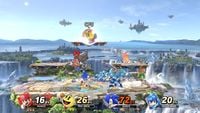
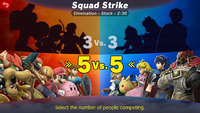
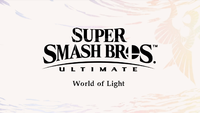


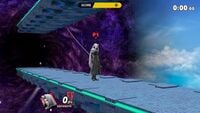

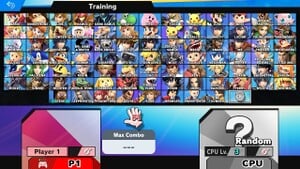

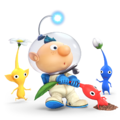
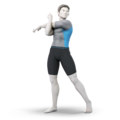
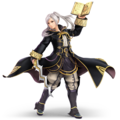





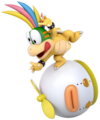


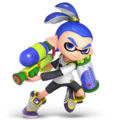
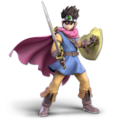
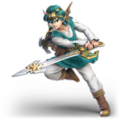
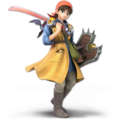























































































































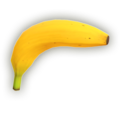
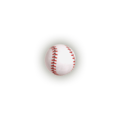
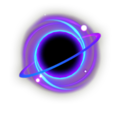
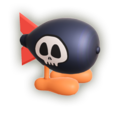
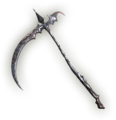
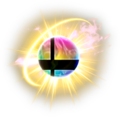
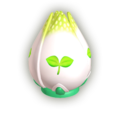
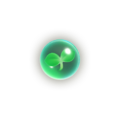
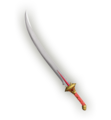
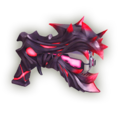

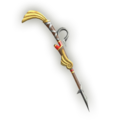
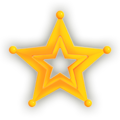
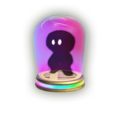
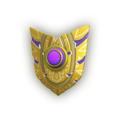
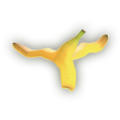
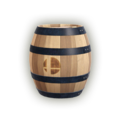
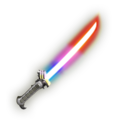
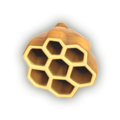
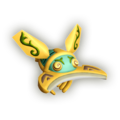
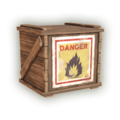
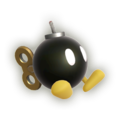
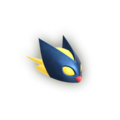
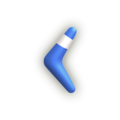
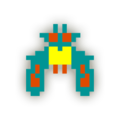
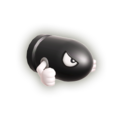

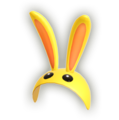
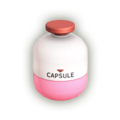
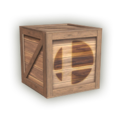
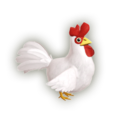
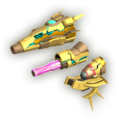
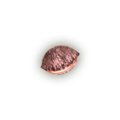
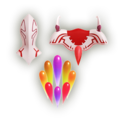
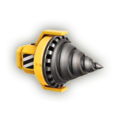
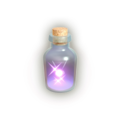
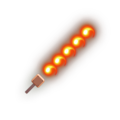
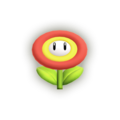
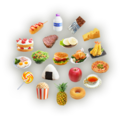
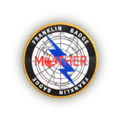
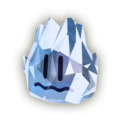
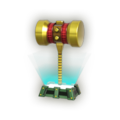
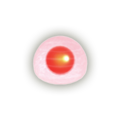
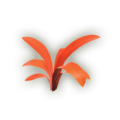
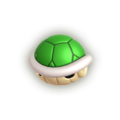
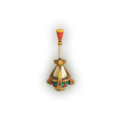
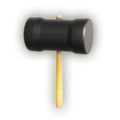
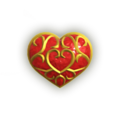
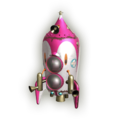
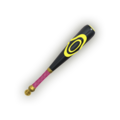
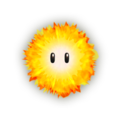
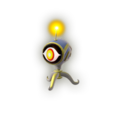
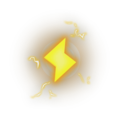
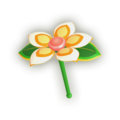
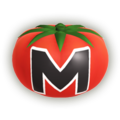
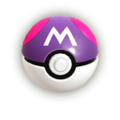
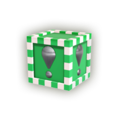
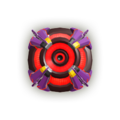
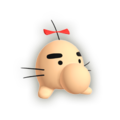
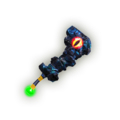
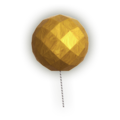
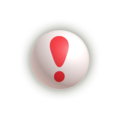
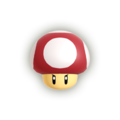
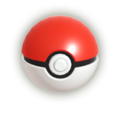
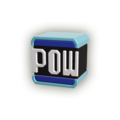
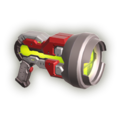
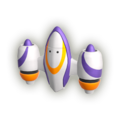
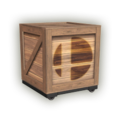
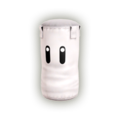
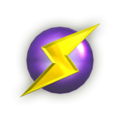
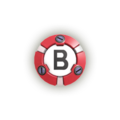
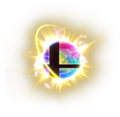
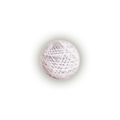
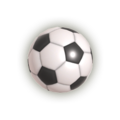
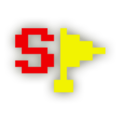
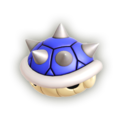
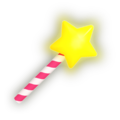
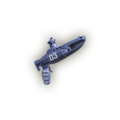
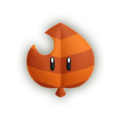
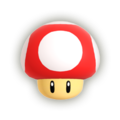
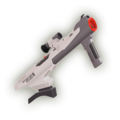
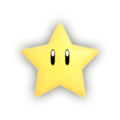
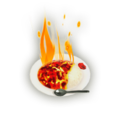
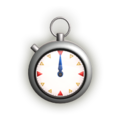
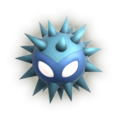
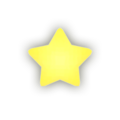
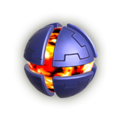
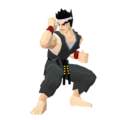
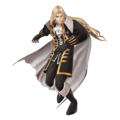
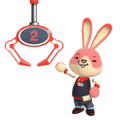
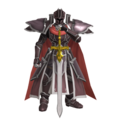
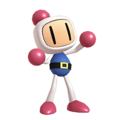
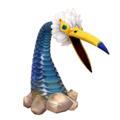
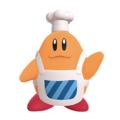

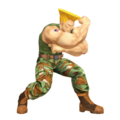
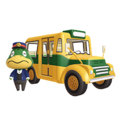
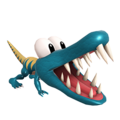
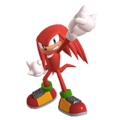
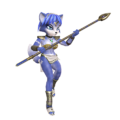
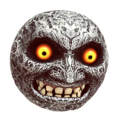

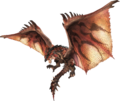
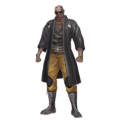
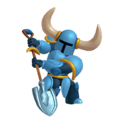
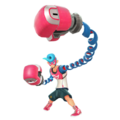

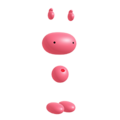
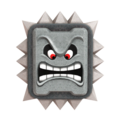
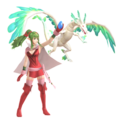
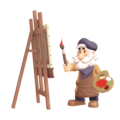
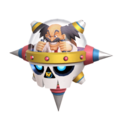
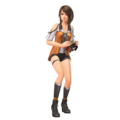
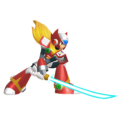
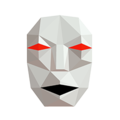
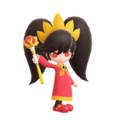
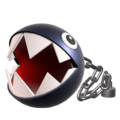
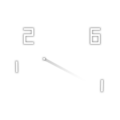
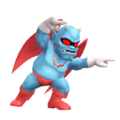
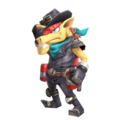
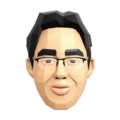
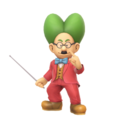
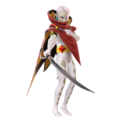
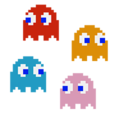
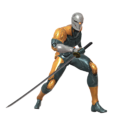
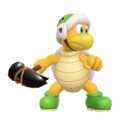
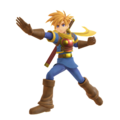
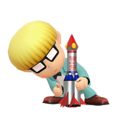
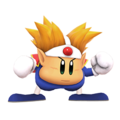

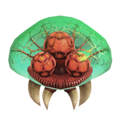
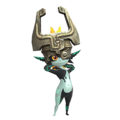
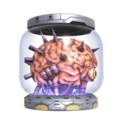
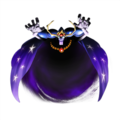
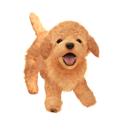
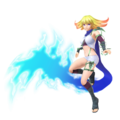
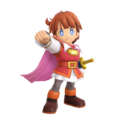
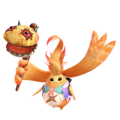
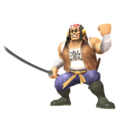
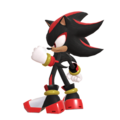
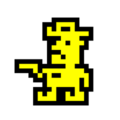
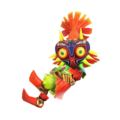
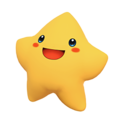
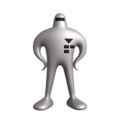
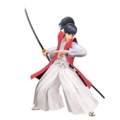
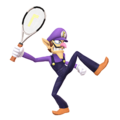
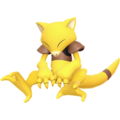
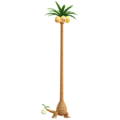
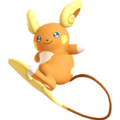
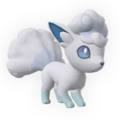
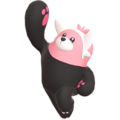
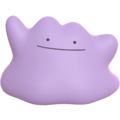
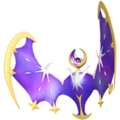
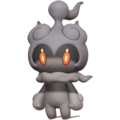
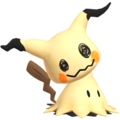
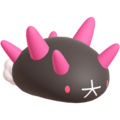
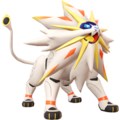
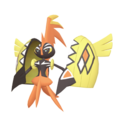
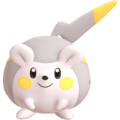
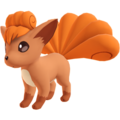
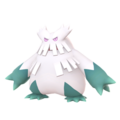
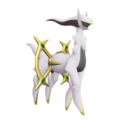
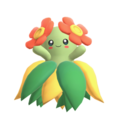
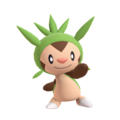
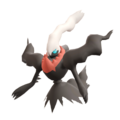
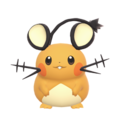
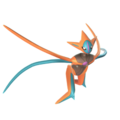
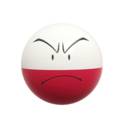
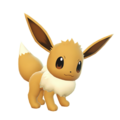
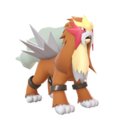
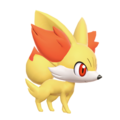
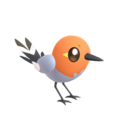
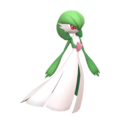
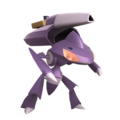
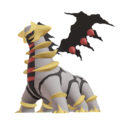
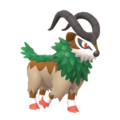
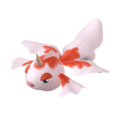
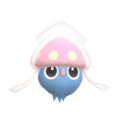
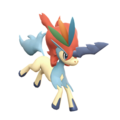
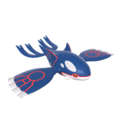
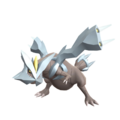
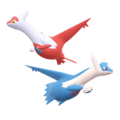
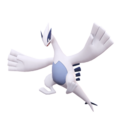
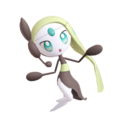
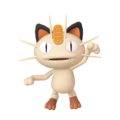
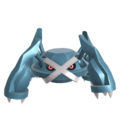
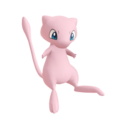
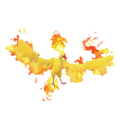
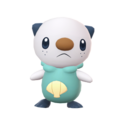
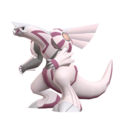
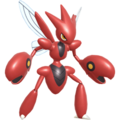

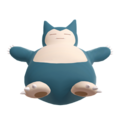
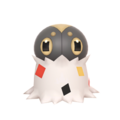
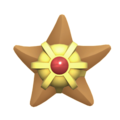
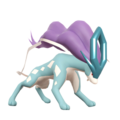
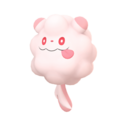
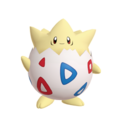
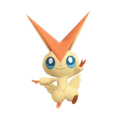
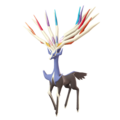
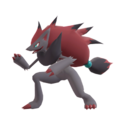
![Wolf[19]](https://mario.wiki.gallery/images/thumb/2/2c/Wolf_amiibo.png/87px-Wolf_amiibo.png)
![Inkling[19]](https://mario.wiki.gallery/images/thumb/0/06/Inkling_amiibo_%28Smash_Series%29.png/94px-Inkling_amiibo_%28Smash_Series%29.png)
![Ridley[19]](https://mario.wiki.gallery/images/thumb/c/cd/Ridley_amiibo.png/109px-Ridley_amiibo.png)
![Ice Climbers[20]](https://mario.wiki.gallery/images/thumb/2/20/Ice_Climbers_amiibo.png/120px-Ice_Climbers_amiibo.png)
![King K. Rool[20]](https://mario.wiki.gallery/images/thumb/3/38/King_K._Rool_amiibo.png/120px-King_K._Rool_amiibo.png)
![Piranha Plant[20]](https://mario.wiki.gallery/images/thumb/0/08/Piranha_Plant_amiibo.png/120px-Piranha_Plant_amiibo.png)
![Young Link[21]](https://mario.wiki.gallery/images/thumb/6/61/Young_Link_amiibo.png/120px-Young_Link_amiibo.png)
![Daisy[21]](https://mario.wiki.gallery/images/thumb/b/ba/Daisy_amiibo.png/120px-Daisy_amiibo.png)
![Ken[21]](https://mario.wiki.gallery/images/thumb/e/e2/Ken_amiibo.png/120px-Ken_amiibo.png)
![Pichu[22]](https://mario.wiki.gallery/images/thumb/1/17/Pichu_amiibo.png/120px-Pichu_amiibo.png)
![Pokémon Trainer[22]](https://mario.wiki.gallery/images/thumb/2/2a/Pok%C3%A9mon_Trainer_amiibo.png/112px-Pok%C3%A9mon_Trainer_amiibo.png)
![Isabelle[22]](https://mario.wiki.gallery/images/thumb/b/b6/Isabelle_amiibo.png/120px-Isabelle_amiibo.png)
![Snake[23]](https://mario.wiki.gallery/images/thumb/5/56/Snake_amiibo.png/112px-Snake_amiibo.png)
![Squirtle[23]](https://mario.wiki.gallery/images/thumb/f/f5/Squirtle_amiibo.png/112px-Squirtle_amiibo.png)
![Ivysaur[23]](https://mario.wiki.gallery/images/thumb/c/ce/Ivysaur_amiibo.png/112px-Ivysaur_amiibo.png)
![Simon[24]](https://mario.wiki.gallery/images/thumb/0/01/Simon_amiibo.png/112px-Simon_amiibo.png)
![Chrom[24]](https://mario.wiki.gallery/images/thumb/5/57/Chrom_amiibo.png/112px-Chrom_amiibo.png)
![Incineroar[24]](https://mario.wiki.gallery/images/thumb/1/19/Incineroar_amiibo.png/112px-Incineroar_amiibo.png)
![Richter[25]](https://mario.wiki.gallery/images/thumb/1/1c/Richter_amiibo.png/112px-Richter_amiibo.png)
![Dark Samus[25]](https://mario.wiki.gallery/images/thumb/b/b2/Dark_Samus_amiibo.png/112px-Dark_Samus_amiibo.png)
![Joker[26]](https://mario.wiki.gallery/images/thumb/c/cd/Joker_amiibo.png/100px-Joker_amiibo.png)
![Hero[26]](https://mario.wiki.gallery/images/thumb/6/6d/Hero_amiibo.png/90px-Hero_amiibo.png)



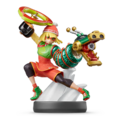
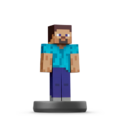
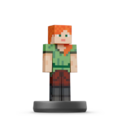
![Sephiroth[27]](https://mario.wiki.gallery/images/thumb/a/a7/Sephiroth_amiibo.png/120px-Sephiroth_amiibo.png)
![Kazuya[27]](https://mario.wiki.gallery/images/thumb/5/59/Kazuya_amiibo.png/120px-Kazuya_amiibo.png)
![Pyra[28]](https://mario.wiki.gallery/images/thumb/f/f4/Pyra_amiibo.png/120px-Pyra_amiibo.png)
![Mythra[28]](https://mario.wiki.gallery/images/thumb/0/0a/Mythra_amiibo.png/120px-Mythra_amiibo.png)
![Sora[29][30]](https://mario.wiki.gallery/images/thumb/0/07/Sora_amiibo.png/120px-Sora_amiibo.png)
